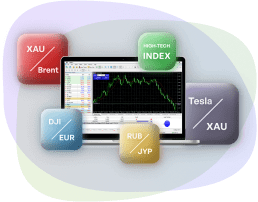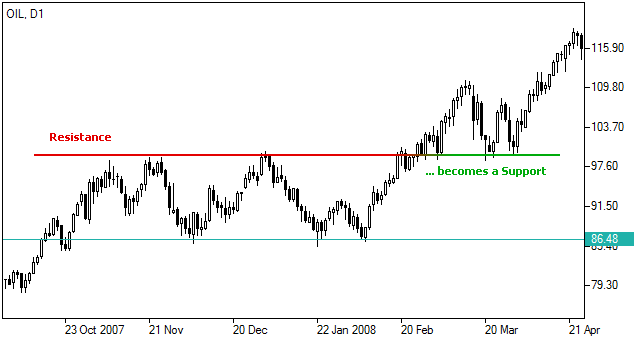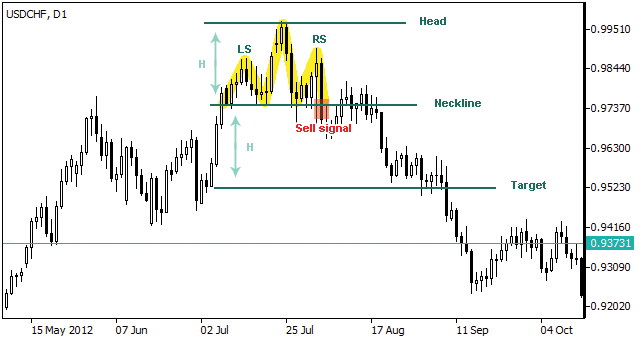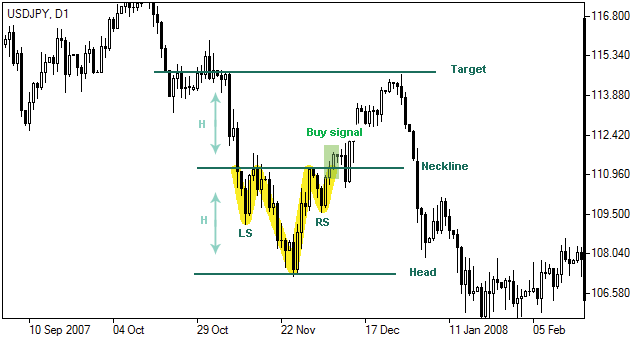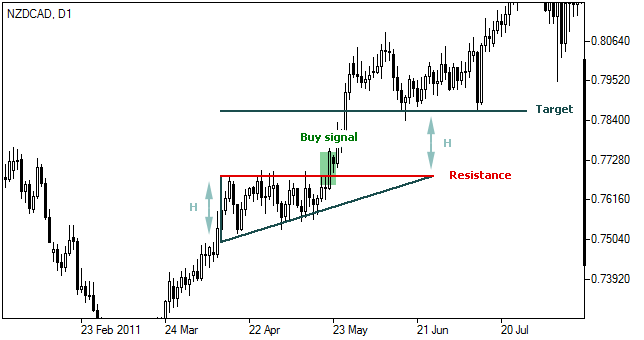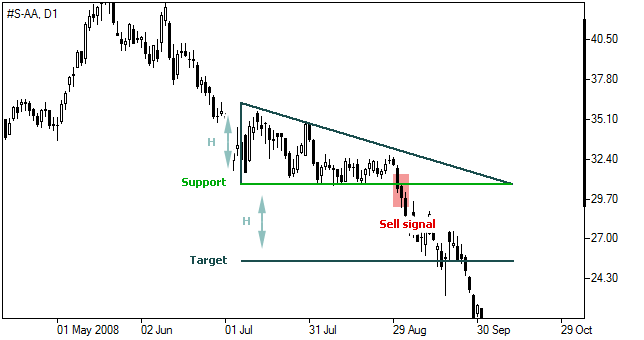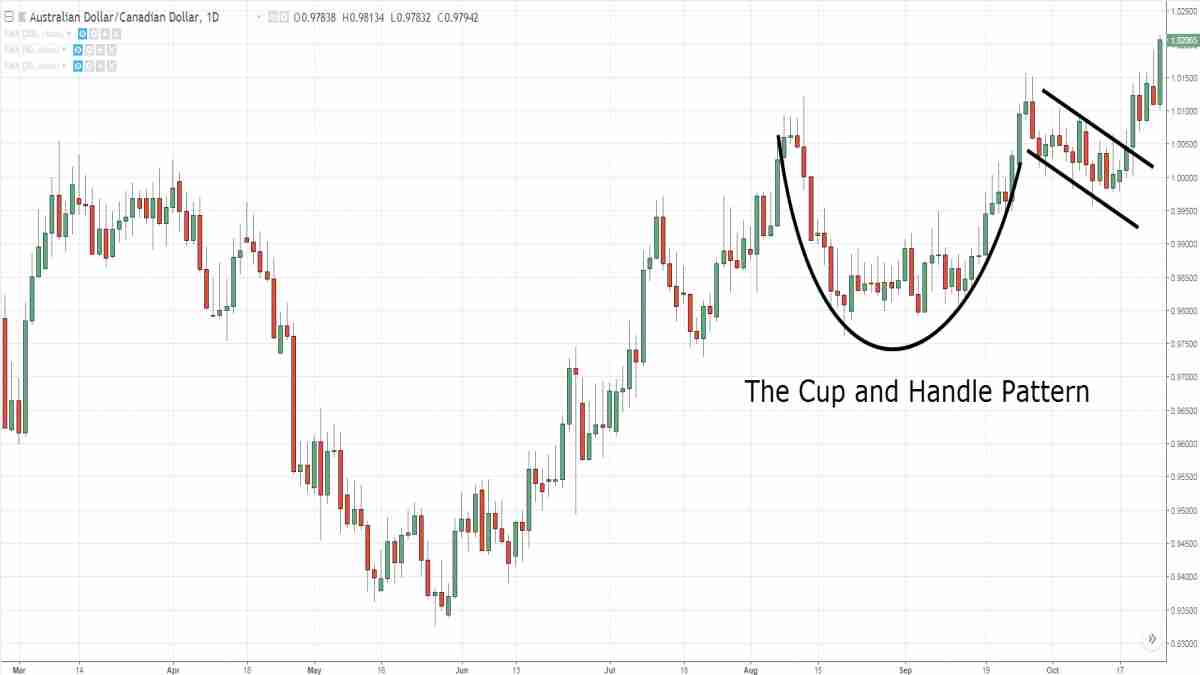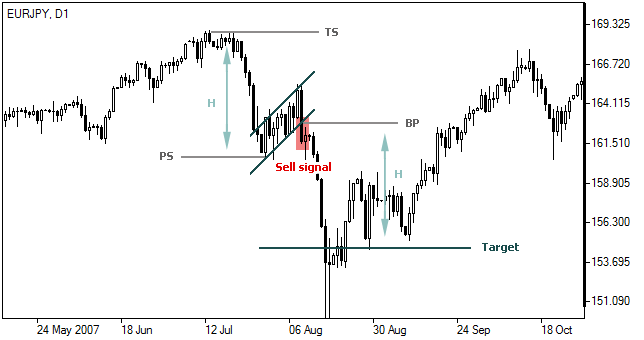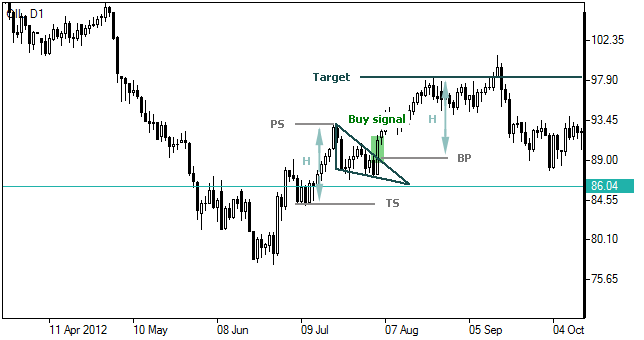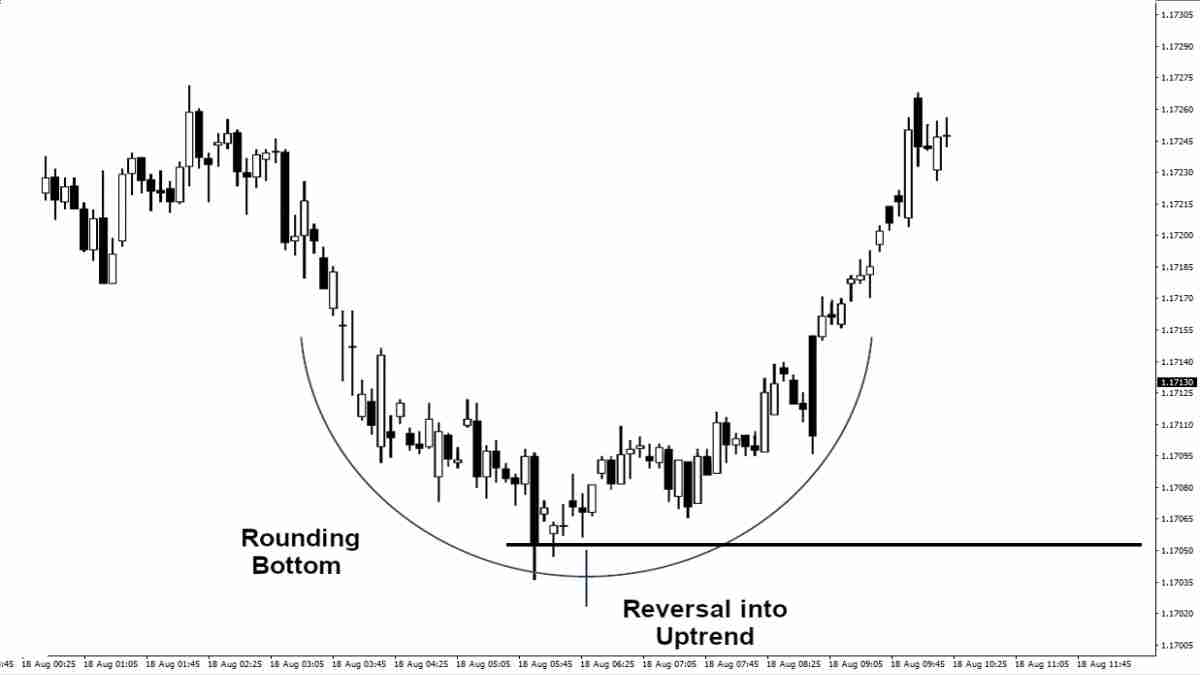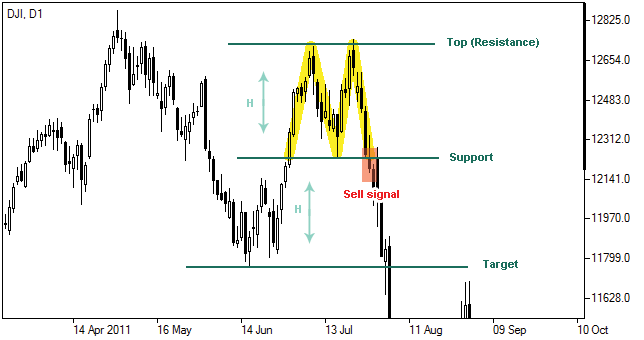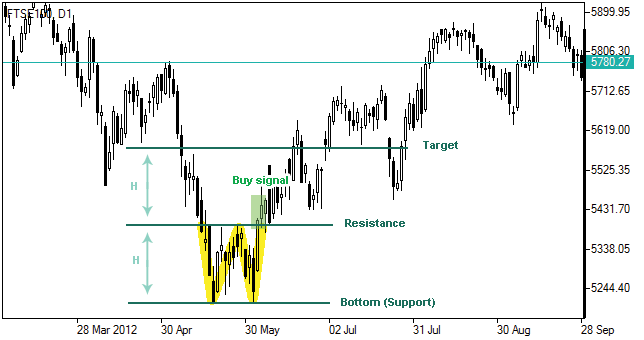- Education
- Forex Trading Strategies
Forex Trading Strategies
What is Forex Trading Strategy
In a highly volatile market where prices move rapidly, traders are in dire need of something tangible to rely on, here comes forex trading strategies. Forex trading strategy is a technique used by forex traders to help decide whether to buy or sell a currency pair at any given time. In trading, you may need our other article about "What is Forex Trading and How does it Work".
Forex trading strategies can be based on either technical analysis, fundamental analysis, or both. Strategies usually build on Forex trading signals, which are in their essence triggers for actions. There are well known forex trading strategies that can be easily found or traders themselves can construct their own. You may also be interested in one of the most popular trading instrument - cryptocurrency trading. To improve your knowledge of crypto trading you can learn cryptocurrency trading strategies.
Types of Trading Strategies
Swing trading
This strategy is a long term trading strategy, when trades are kept open from a few days to, sometimes, several weeks. Swing trading strategy’s essence is taking advantage of market big fluctuations "swings".
Fundamental analysis plays an important role on longer timeframes. Strong directional moves are often triggered by important or unexpected market news, such as corporate income statements or central bank meetings, which means swing traders need to be aware of market fundamentals.
There are ways to develop a reliable trading plan. Here are the most common swing trading techniques we’d like to share with you.
Swing Trading Tactics previews
- Moving average crossovers - When the shorter-term MA crosses above the longer-term MA, it's a buy signal, as it indicates that the trend is shifting up. This is known as a "golden cross."
- Cup-and-handle patterns - A cup and handle is a technical chart pattern that resembles a cup and handle where the cup is in the shape of a "u" and the handle has a slight downward drift. A cup and handle is considered a bullish signal extending an uptrend, and is used to spot opportunities to go long.
- Head and shoulders patterns - A head and shoulders pattern is a technical indicator with a chart pattern described by three peaks, the outside two are close in height and the middle is highest. A head and shoulders pattern describes a specific chart formation that predicts a bullish-to-bearish trend reversal.
- Flags - Flags are areas of tight consolidation in price action showing a counter-trend move that follows directly after a sharp directional movement in price. The pattern typically consists of between five and twenty price bars. Flag patterns can be either upward trending (bullish flag) or downward trending (bearish flag).
- Triangles - A triangle is a chart pattern, depicted by drawing trendlines along a converging price range, that connotes a pause in the prevailing trend. Technical analysts categorize triangles as continuation patterns.
Key reversal candlesticks
Key reversal candlesticks, as well, can be used to complement basic tactics for more accurate execution. A key reversal is a one-day trading pattern that may signal the reversal of a trend. Other frequently-used names for key reversal include "one-day reversal" and "reversal day."
Forex Trading Strategies That Work
There are many circulating Forex trading strategies in trading and sometimes it can be confusing which one to choose. Which one works? Below we will share with you the most successful ones.
These are trading strategies that work well during Forex trading executions.
Scalping trading strategy is very popular in Forex trading Scalpers focus on making profit on small moves that occur frequently and favour markets that aren't prone to sudden price movements. Strategy involves opening a large number of trades in a bid to bring small profits per each. The disadvantage of scalping is that traders can't afford to stay in a trade for too long, plus scalping takes a lot of time and attention to find new trading opportunities.
For example a trader scalping to profit off price movements for Adidas AG Stock trading for $318. The trader will buy and sell a huge amount of Adidas AG shares, let's say 100,000, and sell them during price movements of small amounts. Price increments can be as low as $0.05 or less, making small profits from each share, but since purchase and sale are in bulk, profits could be quite solid.
Day Trading strategy refers to trading during trading day. Quite simple - all trades must open and close during the trading day. Day trading strategy is applicable in all markets, though it's used more in currency trading. When executing day trading strategy, trader monitors and manages open trades the market throughout the whole day.
Note, leaving positions open overnight fraught with loss of money.This type of strategy is often news based, specifically scheduled events - economic news, statistics, elections, interest rates. Basically, one of the ways to execute this strategy is to pay close attention to news that can affect currencies, and act accordingly. That’s why more often than not day traders trade more actively in the mornings, since most news is released at that time.
There are a few unwritten rules day traders should follow to insure themselves from risks:
- Day traders follow a one-percent rule - never put more than 1% of capital or trading account into a single trade. If a trader has $10,000 in a trading account, position in any given instrument shouldn't be more than $100.
- Setting stop loss and take profit points - is the price at which a trader will sell a stock and take a loss on the trade (this happens when trade doesn’t go the way it was planned, in a way it’s a cutting losses approach).
- Setting Take-profit point is the price at which a trader will sell a stock and take a profit on the trade.
Position Trading is a long term strategy, some call it “buy and hold” strategy. During Position Trading strategy traders usually use long term charts, from daily to monthly, and with a combination of other methods establish the trend of the current market. This kind of trade lasts from a few days to several weeks or more. The main idea of position trading strategy is to determine the direction of the market and make use of.
Minor market fluctuations aren't considered important since they don't create trends, hence no impact on position trading strategy, unlike Scalping where the whole strategy is based on it. Since position trading strategy leans on fundamental analysis it's reasonable to monitor central bank monetary policies, political developments as well as long term technical indicators and macroeconomic environment.
Trading Strategies Based on Forex Analysis
Perhaps the major part of Forex trading strategies is based on the main types of Forex market analysis used to understand the market movement. These main analysis methods include technical analysis, fundamental analysis and market sentiment.
Each of the mentioned analysis methods is used in a certain way to identify the market trend and make reasonable predictions on future market behaviour. If in technical analysis traders mainly deal with different charts and technical tools to reveal the past, present and future state of currency prices, in fundamental analysis the importance is given to the macroeconomic and political factors which can directly influence the foreign exchange market. Quite a different approach to the market trend is provided by market sentiment, which is based on the attitude and opinions of traders. Below you can read about each analysis method in detail.
Forex Technical Analysis Strategies
Technical Analysis Strategy
Technical analysis is the most useful tool a trader can rely on. It helps predict price movements by examining historical data - what is most likely to happen based on past information. Though, the vast majority of investors use both technical and fundamental analysis to make decisions.
Before diving into the technical analysis strategies, there is one more thing traders usually do - there are generally two different ways to approach technical analysis: the top-down approach and the bottom-up. Basically the top-down approach is first a macroeconomic analysis and then a focus on individual securities. The bottom-up approach focuses on individual stocks rather than a macroeconomic perspective.
Technical Trading Strategies
The idea behind technical trading strategies is to find a strong trend followed by price rollback. Rollback should last for a short period of time, as soon as price retracement pauses trend will resume and continue moving in the direction of prevalent trend.
PRACTICE MAKES PERFECT
Technical analysis trading is useful for any type of market from stock trading, Forex trading and, even cryptocurrency trading.
For example, an investor could use technical analysis on a stock like (S-GOOG) Alphabet Inc. - get a report to decide if it is a buy or not in 2021. The chart could show Alphabet's price and trading volume.
Forex Technical Analysis Strategies
The first most important strategy to keep in mind when choosing a Forex technical analysis strategy - following one single system all the time is not enough for a successful trade.
Forex Trend Trading Strategy
What is Trend Trading
A trend is nothing more than a tendency, a direction of market movement, i.e. one of the most essential concepts in technical analysis. All the technical analysis tools that an analyst uses have a single purpose: to help identify the market trend.
The meaning of the Forex trend is not so much different from its general meaning - it is nothing more than the direction in which the market moves. But more precisely, the foreign exchange market does not move in a straight line, its moves are characterized by a series of zigzags that resemble successive waves with clear peaks and troughs or highs and lows, as they are often called.
Trend trading is considered a classic trading strategy, as it was one of the first of them, and takes its rightful place today. We believe that trend trading will remain relevant among traders around the world in the future. All thanks to three main, but simple principles:
- Buy, when the market goes up, i.e. we are seeing an uptrend/bullish trend
- Sell, when the market goes down, i.e. we are seeing a downtrend/bearish trend
- Wait and take no action when the market moves neither up nor down, but horizontally, i.e. we are seeing a sideways trend/consolidation
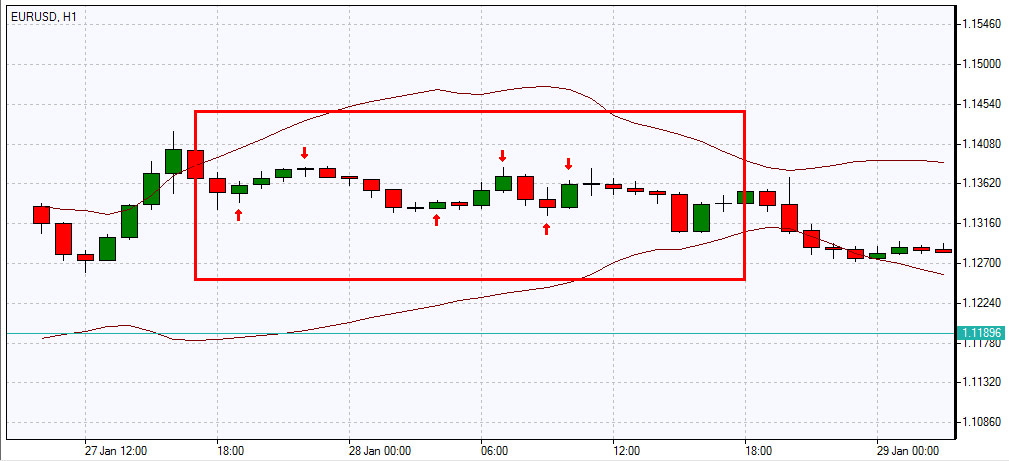
Sideways trend
Trend Following Strategy
The trend following strategy can be applied to trade on a wide variety of timeframes, but the most accurate forecasts and lower risks relate to medium and long-term trading, where stronger and long-lasting trends are observed. Trend trading can be the best choice for swing traders, position traders, i.e. those who see and predict the direction of the market movement in the future. However, both scalpers and day traders also catch trends, but less strong and very short-lived, a sort of fluctuations within the main trend.
Any trader, regardless of their trading method, must, first of all, use technical analysis to determine the current trend in the market of a traded asset and try to predict its further development, using technical analysis.
The technical analysis tools applied are usually extremely simple and user-friendly, each trader can select a variety of indicators, lines, time frames, etc., based on the characteristics of the asset they invest in, their individual
preferences, and other factors. However, the most commonly used ones are moving averages of different periods:
Bollinger bands, the Williams Alligator, Ichimoku cloud, Keltner
channels, MACD, and ADX indicators, as well as various advanced modifications of classic indicators.
Since the indicators are inherently lagging, i.e. reflect the impact of past events and market movements, it is also important to use oscillators to predict the development of the trend and identify the entry points, set stop loss, take profit, trailing stop orders correctly.
Here are three main techniques for entering the market:
- Classic (i.e., entering the market at the intersection of two moving averages)
- At a breakout (i.e., placing a pending order and entering the market after confirming the price intention to continue the trend)
- At a retreat (i.e., entering the market not immediately by a trading signal, but later, when the price is at a more favorable level)
Breakout and classic techniques have some similarities, for example, in both cases, the absence of a take profit order and the setting of a trailing stop would be a rational decision. Entering the market at a retreat is riskier since there is no guarantee the trend will continue as intended rather than reverse.
Before going back to the types of trends in Forex, you should know "What is Forex Trading". If you're good let's continue to the types of trends in Forex. According to the theory of supply and demand, the market has 4 main phases of development:
- Accumulation (sideways movement, consolidation).
- Markup (bullish trend/uptrend).
- Distribution (sideways movement, consolidation).
- Markdown (bearish trend/downtrend).
In fact, on a two-dimensional chart, the trend can move up (phase №2), down (phase №4), or remain relatively horizontal (phases №1 and №3). Let's go through each of the types of trends in Forex separately.
An uptrend, or bullish trend, is a movement in the price of an asset when the lows and highs progressively increase, i.e. every next maximum/minimum is higher than the previous maximum/minimum. In fact, the bullish trend identifies growth in price in a specific timeframe.
As a rule, traders begin to actively buy exactly on the ascent of the trend line, but often they open positions when the bullish bias reaches its peak and flows into the phase of distribution, in which the price moves horizontally and prepares for the final phase of the bullish trend.
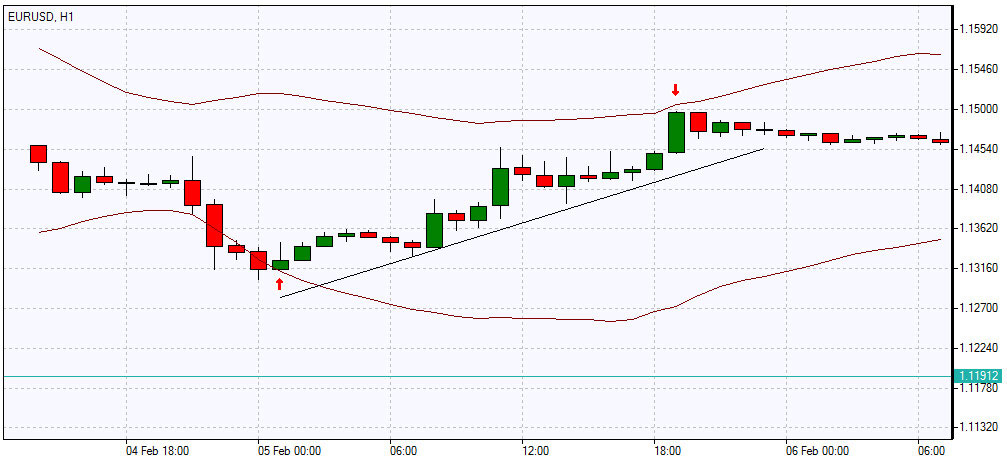
Bullish trend
However, non-professional traders hold their positions longer than necessary at the end of an uptrend, hoping for the trend to continue, and often move into drawdown and lose their investments. More experienced traders manage to correctly detect the end of the 1st market phase, i.e. just before the price advances, and open long positions.
Short positions are opened either during the distribution phase or at the very beginning of the 4th phase when the trend reverses. The current bullish trend can be detected by drawing the support line at the low
points:
the price bounces up at the lows as if pushing off the support line, thereby increasing the highs. If the support line vector on the chart is pointing up, then this is definitely an uptrend.
A downtrend, or bearish trend is a movement in the price of an asset when the lows and highs consistently decrease, every next maximum/minimum is lower than the previous maximum/minimum. In fact, the bearish trend identifies a fall in price in a particular timeframe. The downtrend goes through the same phases and in the same sequence as an uptrend: accumulation of positions, stabilization of the trend, distribution (consolidation).
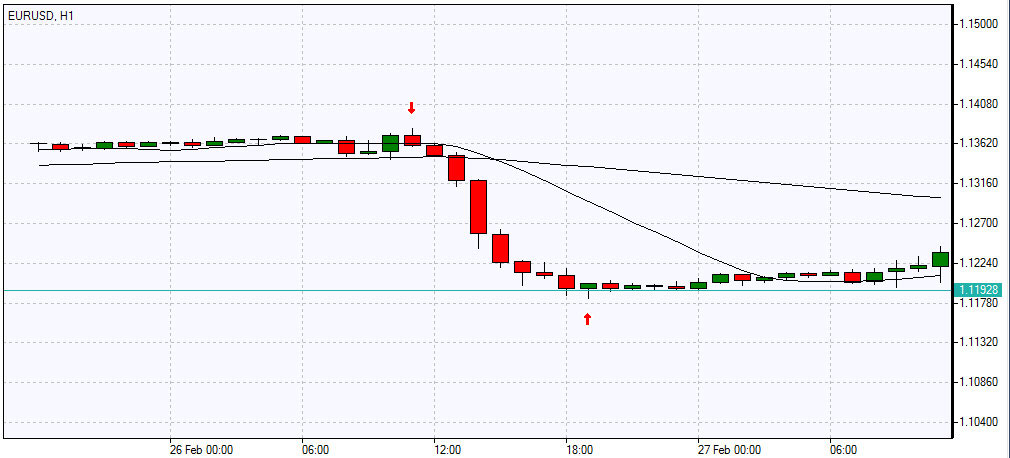
Bearish trend
However, if traders go long during the uptrend, then the downtrend implies the opening of short positions, and it is important to set sell orders (including pending orders) within the distribution phase at the desired price.
In a downtrend, the trend line (in this case, the resistance line) is drawn along the tops:
the price, as if meeting resistance, repels and tends downward, then, with a slight correction, rises back to the support
line and bounces off. If the resistance line vector on the chart is directed downward, then this is definitely a downtrend.
There is an expression popular among traders: “Trend is your friend” which applies to both the uptrend and the downtrend. However, we can observe an apparent trend only 20-30% of the time, the rest of the time the market is relatively neutral and remains flat, i.e.the price is traded in a narrow range, shifting between resistance and support lines.
A sideways trend, or consolidation, occurs when the potential of bears and bulls becomes equal, this often happens before the release of important macroeconomic and other news, since traders do not know exactly how this news will affect the movement of the asset’s price. That is why the sideways trend acts as the first and third market phases when positions are accumulated and distributed.
Also, sideways movement occurs due to the lack of players in the market between trading sessions or during trading of any asset at an atypical time for it. Trading in a sideways trend is possible, but extremely risky. Such a movement will work more for scalpers who make money precisely from small and frequent fluctuations within predictable limits.
Let's sum up the above with a few remarks:
- The Trend is your friend, definitely. But you shouldn’t trade without taking into account the main principles of money and risk management and in the absence of a well-thought-out strategy.
- Forex trend trading is inherently simple, but this doesn’t mean it is inefficient. The complexity of trading strategies would only hinder the trader.
- At least 2 timeframes are required to identify the trend more reliably.
-
You can visually understand the direction of the trend as follows:
the price from the lower-left corner rises to the upper right corner - a bullish trend;
the price from the upper left corner falls to the lower right corner - a bearish trend;
the price moves flat and horizontally - a sideways trend. - The market moves horizontally about 70% of the time, but trading with such a movement is not worth it unless you have experience and a clear understanding of the market behavior during the accumulation and distribution phases.
- The more often the price meets the resistance/support line and, repelling, keeps the movement vector, the stronger and more stable the trend.
- If the price goes up/down sharply and steeply, the trend is more likely to reverse. If the trend is flatter, evenly rising/falling, then there is a high probability that it will last long.
NEW TO TRADING OR WANT TO
IMPROVE YOUR LEVEL?
Check out our Trading Academy with
professional video lessons
and articles.
Support and Resistance Trading Strategy
Support and Resistance lines
Among the fundamental and most commonly used technical analysis tools, support and resistance (SR) levels have a special place. Moreover, strategies based on them are used not only by beginners, but also by quite experienced traders, who have many other tools at their disposal, as well as extensive trading experience. So why have these simple lines become so widely used by investors? Let's think about this together, but before that we may need to strengthen the knowledge of What is Forex trading and how does it work.
SR levels
SR levels are conditional areas that each trader allocates individually by the price extremes - minimums and maximums, on a certain timeframe. These areas are often represented as lines, however, to calculate all the risks and correctly place orders, it is still better to depict the SR as areas on the chart.
It should be known that support and resistance lines on different timeframes will be drawn in completely different ways. It's worthy to note that SR lines on large timeframes, such as H1, H4, D1 and larger, are more reliable and less likely to be broken through, the same cannot be said for the SR lines drawn on M1, M5 or M15. There are no specific rules about whether to draw levels by candlestick bodies or by their shadows: experts have not yet agreed on this issue. Learn more about How to draw support and resistance.
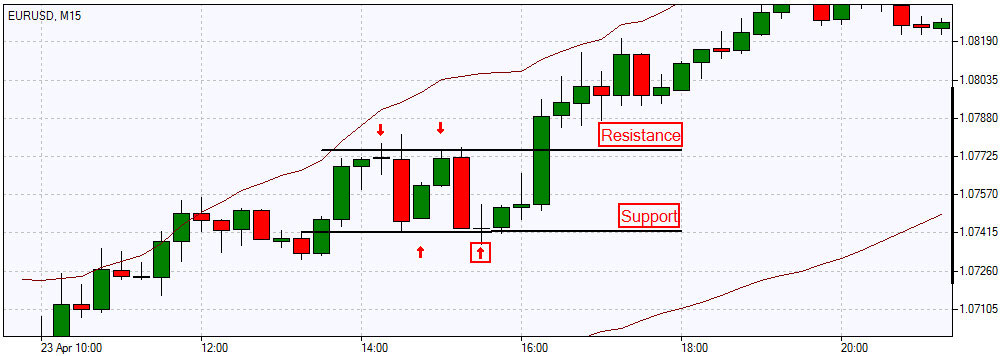
Reasons for the formation of Support and Resistance Areas
To understand how Support & Resistance levels are formed and how to use them, we need to analyze the psychological component of this phenomenon. A market trend formation depends on the prevalence of one of three conditional groups in the market:
- Bears (open sell positions)
- Bulls (open buy positions)
- Undecideds (not yet on the market)
Imagine a situation with the price fluctuating in a consolidation area near the support line. Bears sell assets, bulls actively buy, and then the price begins to rise. In such a situation, the bears regret going short, and as soon as the price returns to the support line, they will close their orders to have a chance to break even.
The bulls are happy with this scenario, since their positions get profitable when the price rises, and at the very first correction of the price to the support line, they will go long again, as they believe the price will bounce off the support level one more time. Those traders who haven’t yet opened orders see that the sideways trend has turned upward and consider the moment of price correction and its rebound from the support level the most favorable for placing buy orders.
Thus, we see a clear BUY sentiment among traders at the very first, even slight price movement towards the support line. And when this happens, a huge number of market participants immediately go long, i.e. demand surges sharply, and supply does not keep pace with it, so the price rises as expected. The situation is reversed in the case of the resistance line, where supply rises steeply and demand slips downwards.
With such a common example, we can see a direct relationship between the Supply/Demand ratio and the Support/Resistance levels vector. This is why Support/Resistance lines are often called Supply/Demand levels.
How to trade using support and resistance levels?
We have sorted out the reasons how the S/R areas form. Now let's look at trading strategies based on support and resistance levels. When on the chart the price approaches the support or resistance line, it is expected to either bounce off that line or break it.
So, traders distinguish 3 types of trading based on the Support/Resistance levels: trading based on a rebound from levels (range trading), trading based on a level breakout, and a mixed type of trading (allows you to use both strategies alternately, depending on the current market situation). Let’s consider the two key strategies:
Range Trading
From the example above, it can be seen that with a significant accumulation of bullish potential, as the price approaches the support line, it is more likely that the price will reverse from the level. Then you can go long, placing the stop loss below the support level.
When the price moves towards the resistance line, and bearish sentiments prevail in the market, traders begin to actively open sell orders, as soon as the price reaches the Resistance level. As a result, the price bounces off the level and goes down.
In this case, the stop loss is usually placed above the resistance level. Using a take profit order and trailing stop mode also reduces the risk of losses and helps to fix profits in time. A rebound from levels occurs most often within consolidation (actually, the market is in this phase about 70% of the time), since the price alternately bounces from one level to another, so such trading is quite attractive for scalpers and short-term traders: insignificant profit per trade is compensated by the frequency of orders.
Breakout Trading
With large volumes in the market and a strong trend movement, the price may break through the support or resistance line, instead of reversing from it. Trend traders benefit the most from this price behavior.
- If the price breaks the resistance level from the bottom up, then returns to this level during correction, the price is not always able to punch it from the other side, so it bounces up from the level, forming an upward trend. Thus, after the breakout the resistance line turns into a support line.
- If the price breaks through the support line from top down, and upon returning to this line, the price isn’t always able to break it from the opposite side now, so it ricochets off the level and continues its downward movement, becoming a downtrend. In this case, the support line is transformed into a resistance line after the breakout.
- In some cases, after breaking through the support/resistance level once, the price crosses it back from the opposite side during the correction and returns to the previous price range. It's called a false breakout.
Key Takeaways of Support and Resistance Trading
- Trading based on support and resistance levels is suitable for all types of markets: currency, commodity, stock. Also, it is applicable to any timeframe.
- The principles of such trading are simple and straightforward.
- It is easy to identify support and resistance zones with the help of moving averages and trend lines on any timeframe. They often act as Support/Resistance levels themselves.
- Levels are a universal tool for technical analysis. They are unbiased, since most traders are guided by them.
- The more often a level is tested, the stronger it is considered. However, you need to be extremely careful in order to timely notice changes in the trend and its possible reversal.
- Several false breakouts indicate the stability and strength of the level.
- Fibonacci levels, moving averages of at least two large periods with round numeric values, the Lines algorithm, the PZ and IchimokuSuppRes indicators, Pivot Points, Bollinger Bands, Fractals and many others can help identify the S/R areas.
In conclusion, it’s worth noting that the concepts of Support and Resistance levels are not new in trading; many investors are guided by them and build their strategies accordingly.
However, there are also those who believe that the levels based on old data may be useful in analyzing the market development in the past, but not in predicting the future movements, since there are no guarantees that the market will behave in one way or another, because there are plenty of factors influencing the market, and the behavior of millions of market participants is unpredictable.
PRACTICE MAKES PERFECT
Forex Range Trading Strategy
KEY TAKEAWAYS
- Range trading is a forex trading strategy that involves the identification of overbought and oversold currency.
- Range trading strategy is sometimes criticized for being too simplistic, but in actuality it never failed.
- Traders, should look at long-term patterns that may be influencing the development of a rectangle.
- The complexity of irregular ranges requires traders to use additional analysis tools to identify these ranges and potential breakouts.
Forex Range Trading Strategy
Traders generally look for the best trading strategy to help them profit. Before attempting range trading, traders should fully understand its risks and limitations. Range trading strategy is becoming increasingly popular lately. But before we start, if you are new to Forex trading, it is best to start with the basics, “What is Forex trading and how does it work”.
Range trading is a forex trading strategy that involves the identification of overbought and oversold currency, i.e buying during oversold/support periods and selling during overbought resistance periods. This type of strategy can be implemented nearly at any time, though it is preferable to use it when the market doesn’t have any distinguished direction, meaning is most effective when the Forex market has no discernible long-term trend in sight.
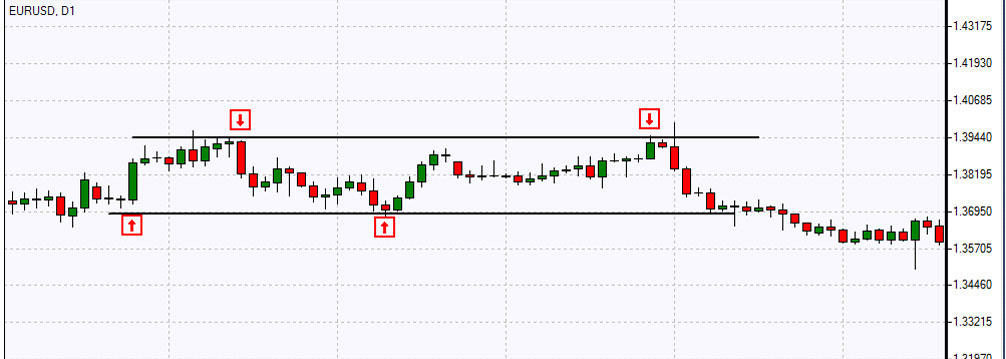
What is Range Trading
Range trading is an active investing strategy that identifies a range at which the investor buys and sells at over a short period. For example, a stock is trading at $55 and you believe it is going to rise to $65, then trade in a range between $55 and $65 over the next several weeks.
Traders might attempt to range trade it by purchasing the stock at $55, then selling if it rises to $65. Trader will repeat this process until he/she thinks the stock will no longer trade in this range.
Types of Range
To successfully trade while using Range trading strategy traders should know and understand the types of ranges. Here are the four most common types of range that you will find useful.
Rectangular Range - When using range trading strategy traders will see a rectangular range, there will be sideways and horizontal price movements between a lower support and upper resistance, it's common during most market conditions.
From the chart it is easy to see how the price movement of the currency pair stays within the support and resistance lines creating a rectangular (hence the name) range, from which traders clearly can see possible buy and sell opportunities.
Note: traders, should look at long-term patterns that may be influencing the development of a rectangle.
Diagonal Range is a common forex chart pattern. This type of range establishes upper and lower trendlines to help identify a possible breakout. In a diagonal range, the price descends or ascends via a sloping trend channel. This channel can be broadening, or narrowing.
Note: diagonal range breakouts take place relatively quickly, some can take months or years to develop, traders have to make decisions based on when they expect a breakout to occur, which can be hard.
Continuation Ranges is a graphical pattern that unfolds within a trend. These ranges occur as a correction against a predominant trend and can occur at any time as a bearish or bullish movement.
Note: continuation patterns take place within other trends, there is added complexity to evaluating these trades, especially for novice traders it is going to be hard to spot continuation ranges.
Irregular Ranges emerge differently from the previous three: trend take place around a central pivot line, and resistance and support lines crop up around it. That’s why it’s hard determining support and resistance lines. “Excellence" is not a gift, but a skill that takes practice, and applies to all Forex patterns.
Note: The complexity of irregular ranges requires traders to use additional analysis tools to identify these ranges and potential breakouts.
Bottom Line on Range Trading Strategy
Traders that choose to use Range trading strategy have to understand not only types of ranges, but the strategy lying behind using it.
Range trading strategy is sometimes criticized for being too simplistic, but in actuality it never failed. Traders need to identify the range, time their entry and control their risks of exposure and of course understand the fundamentals of hte strategy. Range trading can be quite profitable.
NEW TO TRADING OR WANT TO
IMPROVE YOUR LEVEL?
Check out our Trading Academy with
professional video lessons
and articles.
Technical Indicators Trading Strategy
Trading strategies often use technical indicators to determine entry, exit or trade management rules and sometimes strategies use more than just one indicator which helps to identify the moment trades should occur.
From this article, you will learn that even though the indicators and trading strategies are different, they are both used in tandem by technical analysts to determine trading setups with high probability. But if you are new to Forex trading, you can read our other article "What is Forex trading" and then continue reading about the technical indicators strategy.
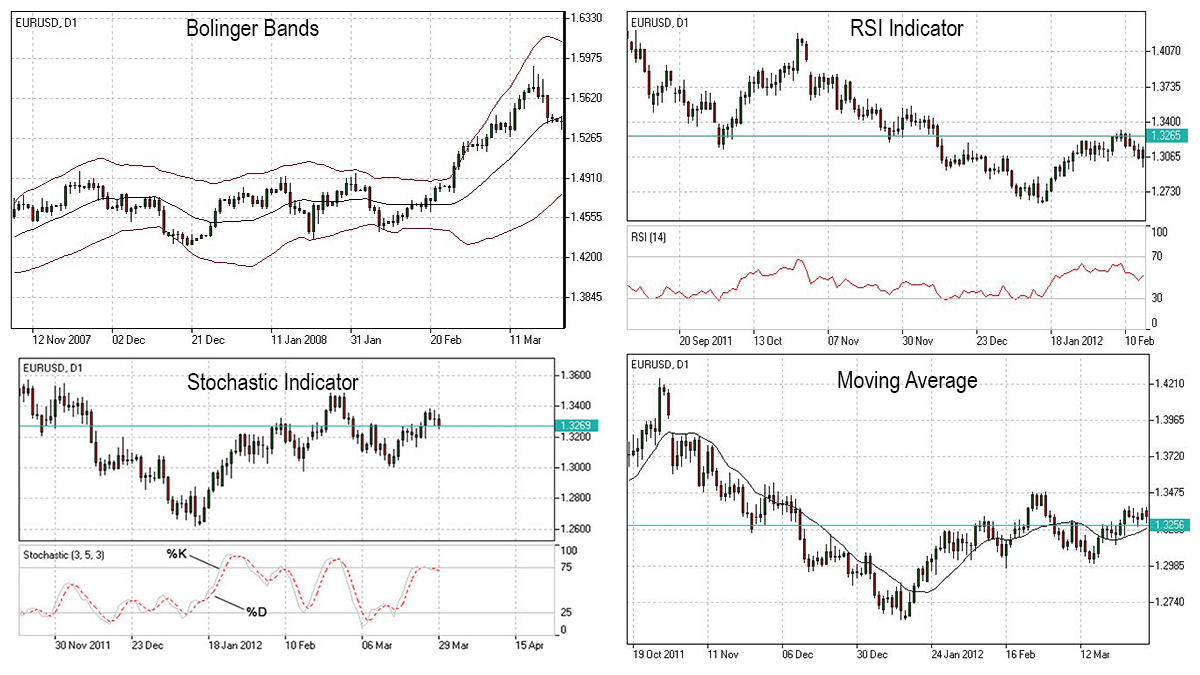
KEY TAKEAWAYS
- Technical indicators are used to see past trends to anticipate future moves.
- There are several technical indicators that can be divided into two main categories: Overlays and Oscillators.
- Frequently, one of the indicators is used to confirm the other indicator's accuracy.
- With a wide variety of indicators at hand, traders should choose the indicators that work best for them and become familiar with how they work.
Technical Indicators Trading Strategy
First let’s understand what technical indicators are.
Technical indicators are pattern-based signals produced by the price, volume, and open interest rates of a security. Technical analysis is trading that helps to evaluate investments and identify trading opportunities by analyzing statistical trends gathered from trading activity.
When using indicators the goal is to identify trading opportunities. So the idea behind technical trading strategies is to find a strong trend followed by price rollback. Rollback should last for a short period of time, as soon as price retracement pauses trend will resume and continue moving in the direction of prevalent trend.
Traders when implementing strategies usually use trade filters and triggers which are most of the time based on indicators.
- Trade filters - when investing, a filter is used to narrow down the number of choices from a given set of securities.
- Тrade triggers - used to automate certain types of trades, such as the selling or buying shares when the price reaches a certain level.
For example Moving Average can be used to identify trade filters and trade triggers, like buying when price moves above the moving average and vice versa. Surely it doesn't stop there, there are a few more clarifications that need to be done, because a simple rule lacks definitive details for taking action, like - how far above the moving average does price need to move or What type of order will be used to place the trade. But now you get the idea, how indicators can be used in strategy.
An indicator stand alone is not a trading strategy. Indicators help understand the market, but a plan of implementation, so called rule book of investments and trading is strategy, where traders can use multiple technical indicators.
Main question for traders is to choose the right indicators for the strategy, since traders build their strategy based on the risk tolerance and preferences they have, indicators need to be chosen accordingly.
- A trader with long-term moves preferences and large profits might choose to focus on a trend-following strategy, therefore, will pick a moving average indicator as a stepping stone.
- A trader interested in short term transactions with frequent small gains might be inclined in a strategy based on volatility.
Note: Frequently, one of the indicators is used to confirm the other indicator's accuracy.
Technical Indicators Trading
- Overlays (are applied over the prices on the exchange chart)
- Moving Average - the reason for calculating the moving average of a stock is to help smooth out the price data by creating a constantly updated average price. Random, short-term fluctuations on the price of a stock over a specified time-frame are soften.
- Bollinger Bands - tool defined by a set of trend lines, applied two standard deviations (positively and negatively) away from a simple moving average (SMA) of a security's price. It gives investors a higher probability of properly identifying when an asset is oversold or overbought.
- Oscillators (are applied above or below a price chart)
- Stochastic Oscillator - is a momentum indicator comparing a particular closing price of a security to a range of its prices over a certain period of time. It is used to generate overbought and oversold trading signals, utilizing a 0–100 bounded range of values. The general idea is that in a market trending upward, prices will close near the high, and in a market trending downward, prices close near the low.
- Moving Average Convergence/Divergence (MACD) - is a trend-following momentum indicator that shows the relationship between two moving averages of a security’s price. MACD triggers technical signals when it crosses above (to buy) or below (to sell) its signal line. It helps investors understand whether the bullish or bearish movement in the price is strengthening or weakening.
- Relative Strength Index (RSI) - is a momentum indicator used in technical analysis that measures the magnitude of recent price changes to assess overbought or oversold conditions in the price of a stock or other asset. RSI is displayed as an oscillator, a line chart that moves between two extremes and can range from 0 to 100.
Bottom Line on Technical Indicators Trading Strategy
When analyzing a security, traders often use many different technical indicators. With a wide variety of indicators at hand, traders should choose the indicators that work best for them and become familiar with how they work. Traders can also combine technical indicators with more subjective forms of technical analysis, such as studying Forex chart patterns which will help to come up with trading ideas. Technical indicators can also be included into automated trading systems, given their quantitative nature.
In general, each trader should determine the correct method in which indicators will be used to signal trading opportunities and facilitate the development of a trading strategy.
NEW TO TRADING OR WANT TO
IMPROVE YOUR LEVEL?
Check out our Trading Academy with
professional video lessons
and articles.
Chart Pattern Trading Strategy - Chart Patterns in Forex
KEY TAKEAWAYS
- There are several trading methods, each of which uses price patterns to find entry points and stop levels
- One limitation shared across many technical patterns is that it can be unreliable in illiquid stocks
- Traders often use chart patterns as a Forex strategy.
Forex Chart Pattern Strategy
Traders often use chart patterns as a Forex strategy.
Forex market has a behavior that shows patterns. Chart patterns usually occur during change of trends or when trends start to form. There are known patterns like head and shoulder patterns, triangles patterns, engulfing patterns, and more. Let us introduce to you some of them, it will help you identify the trend of the market and trade accordingly.
Chart Patterns in Forex
There are several trading methods, each of which uses price patterns to find entry points and stop levels (you can read more about trading in our article " What is Forex trading and how does it work"). Forex charting patterns include head and shoulders as well as triangles, which provide entries, stops and profit targets in a form that can be easily seen.
Head and Shoulders (H&S) chart pattern is quite popular and easy-to-spot in technical analysis. Pattern shows a baseline with three peaks where the middle peak is the highest, slightly smaller peaks on either side of it. Traders use head and shoulders patterns to predict a bullish and bearish movement.
Head and shoulders shaping is distinctive, chart pattern provides important and easily visible levels - Left shoulder, Head, Right shoulder. Head and shoulders pattern can also be inverse and will look like this and the pattern is called Inverse Head and Shoulders.
- Triangles fall under continuation patterns category, there are three different types them:
- Ascending triangle - The ascending triangle pattern in an uptrend, easy to recognize but is also quite an easy entry or exit signal.
- Descending triangle - The Descending triangle is noticable fot its downtrends and is often thought of as a bearish signal.
- Symmetrical triangle - Symmetrical triangles, as continuation patterns developed in markets, are aimless in direction. The market seems apathetic in its direction. The supply and demand, therefore, seem to be one and the same.
At the start of its formation, the triangle is at its widest point, as the market continues to trade, the range of trading narrows and the point of the triangle is formed. Because the triangle narrows it means that both buy and sell sides interest is decreasing - the supply line diminishes to meet the demand.
Chart Patterns Trading
Chart patterns are widely used in trading while conducting technical analysis. Studying these patterns will be useful for building or using as a trading strategy.
Cup and Handle A cup and handle is a technical chart pattern that resembles a cup and handle where the cup is in the shape of a "u" and the handle has a slight downward drift. Looks like this:
It is worth paying attention to the following when detecting cup and handle patterns:
- Length: Generally, cups with longer and more "U" shaped bottoms provide a stronger signal. Avoid cups with sharp "V" bottoms.
- Depth: Ideally, the cup should not be overly deep. Avoid handles that are overly deep also, as handles should form in the top half of the cup pattern.
- Volume: Volume should decrease as prices decline and remain lower than average in the base of the bowl; it should then increase when the stock begins to make its move higher, back up to test the previous high.
Flag is a price pattern that moves in a shorter time frame against the prevailing price trend observed in a longer time frame on a price chart. Reminds the trader of the flag, hence the name. Flag patterns can be upward trending (bullish flag) or downward trending (bearish flag).
Note: Flag may seem similar to a wedge pattern or a triangle pattern, it is important to note that wedges are narrower than pennants or triangles.
- The preceding trend
- The consolidation channel
- The volume pattern
- A breakout
- A confirmation where price moves in the same direction as the breakout
- Wedges form as an asset’s price movements tighten between two sloping trend lines. There are two types of wedge: rising and falling.
- The converging trend lines;
- Pattern of declining volume as the price progresses through the pattern;
- Breakout from one of the trend lines.
- Rounding bottom Chart pattern is identified by a series of price movements that graphically form the shape of a "U". Rounding bottoms are found at the end of long downward trends and signify a reversal in long-term price movements. It could take from several weeks to several months and it happens quite rarely.
- Double top is a bearish technical reversal pattern. Traders use double top to highlight trend reversals. Typically, an asset’s price will experience a peak, before retracing back to a level of support. It will then climb up once more before reversing back more permanently against the prevailing trend.
Double bottom patterns are the opposite of double top patterns. Double bottom patterns if identified correctly are highly effective. Therefore, one must be extremely careful before jumping to conclusions.
The double bottom looks like the letter "W". The twice-touched low is considered a support level.
Flag patterns have five main characteristics:
Wedge patterns are usually characterized by converging trend lines over 10 to 50 trading periods, which ensures a good track record for forecasting price reversals. A wedge pattern can signal bullish or bearish price reversals. In either case, this pattern holds three common characteristics:
The two forms of the wedge pattern are a rising wedge, which signals a bearish reversal or a falling wedge, which signals a bullish reversal.
Bottom line on Chart Pattern Trading Strategy
All of the patterns are useful technical indicators which can help traders to understand how or why an asset’s price moved in a certain way – and which way it might move in the future. This is because chart patterns can highlight areas of support and resistance, the latest in turn can help a trader decide whether they should open a long or short position; or whether they should close their open positions in the event of a possible trend reversal.
NEW TO TRADING OR WANT TO
IMPROVE YOUR LEVEL?
Check out our Trading Academy with
professional video lessons
and articles.
Forex Volume Trading Strategy
KEY TAKEAWAYS
- Forex volume is the number of lots traded in a currency pair each day.
- Volume should be looked at relative to recent history.
- The higher the volume during a price move, the more significant the move and vice versa - the lower the volume during a price move, the less significant the move will be.
- When prices reach new highs or new lows and volume is decreasing, probably reversal is taking shape.
Forex Volume Trading Strategy
Volume Trading is the number of securities traded for a certain time. The higher the volume, the higher the degree of pressure, which, depending on number of nuances, can indicate the beginning of a trend. Volume analysis can help understand the strength in the rise and fall of individual stocks and markets in general.
To determine that, traders should look at the trading volume bars, presented at the bottom of the chart. Any price movement is more significant if accompanied by a relatively high volume + a weak volume. Not all volume types may influence the trade, it’s the volume of large amounts of money that is traded within the same day and greatly affects the market.
What is Forex Volume
Forex volume is probably one of the most important tools traders have at their disposal. Volume in Forex is based only on the individual pair on a given exchange at that point in time. That’s why it’s sometimes overlooked.
Forex volume is the number of lots traded in a currency pair each day. Volume is one of the most accurate ways of measuring money flow. Indicator tells traders about market activity and liquidity, that is, higher trading volumes mean higher liquidity. If you are new to Forex trading, it is best to start with the basics, “What is Forex”.

From the chart above, which is the GBP/USD, volume indicator, paints quite accurate even foreseeing the price picture. Using volume indicator traders can see whether the events, such as economic data publishing, breaking news have influenced the market.
Note: Volume overall tends to be higher near the market's opening and closing times and on Mondays and Fridays. It tends to be lower at lunchtime and before a holiday.
How to Trade with Volume
Volume shows how the market moves - the more volume, the easier it is to decide when to buy or sell (volume can’t tell the difference between bear and bull markets). Volume precedes price action, here are a few general steps to take, before making trading decisions.
1. Trend Confirmation
Traders need increasing numbers and increasing enthusiasm in order to keep pushing prices higher. Increasing price and decreasing volume might suggest a lack of interest, this might be a warning of a potential reversal. A price drop (or rise) on little volume is not a strong signal. A price drop (or rise) on large volume is a stronger signal that something in the stock has fundamentally changed.
2. Exhaustion Moves and Volume
In a rising or falling market, we see movement exhaustion typically, sharp price movements, combined with a sharp increase in volume, signal the potential end of the trend.
3. Bullish Signs
Volume can be useful for spotting bullish signs. For example, volume increases when the price falls, and then the price moves up and then down again. If the price does not fall below the previous low when it moves back, and volume decreases during the second decline, then this is usually interpreted as a bullish sign.
4. Volume and Price Reversals
If, after a prolonged price move higher or lower, the price begins to fluctuate with little price movement and large volume, this may indicate a reversal and prices will change direction.
5. Volume and Breakouts vs. False Breakouts
On the initial breakout from a range or other chart pattern, a rise in volume indicates strength in the move. Little change in volume or declining volume on a breakout speaks of lack of interest - higher probability for a false breakout.
6. Volume History
Volume should be looked at relative to recent history. Comparing today's volume to 50 years ago might provide irrelevant data. The more recent the data sets, the more relevant results are likely to be.
Bottom line on Volume Trading Strategy
Volume is a handy tool for studying trends, and there are many ways to use it. Basic guidelines can be used to gauge market strength or weakness, and to test whether volume confirms price movement or signals an impending reversal. Volume-based indicators are sometimes used to aid decision making.
NEW TO TRADING OR WANT TO
IMPROVE YOUR LEVEL?
Check out our Trading Academy with
professional video lessons
and articles.
Multiple Time Frame Analysis Strategy
KEY TAKEAWAYS
- Multiple time-frame analysis involves monitoring the same currency pair across different frequencies.
- Each time frame has its benefits.
- The methodology behind using multiple time frames is that traders can start to build a clearer picture of the price action and technical analysis story.
Multiple Time Frame Trading Strategy
Traders often use Forex patterns as a Forex strategy.
The multiple time frames trading strategy is a Forex trading strategy that works by following a single currency pair over different time frames. By following the price chart traders can see the highs and lows and establish the overall and temporary trend. However, when looking at the different time frames traders can see changes and patterns that they were not able to spot by using a single time frame.
Each time frame has its benefits. Long time frames allow traders to understand the bigger picture and identify the overall trend. Average time frames present the short term trend and show traders what is happening in the market right now. Short time frames are traders' way of recognizing the exact window for when to make their move.
Multiple Time Frame Analysis
Multiple time-frame analysis involves monitoring the same currency pair across different frequencies. There is no real limit on how many frequencies can be monitored, but there are general guidelines that most traders practice. So, generally traders use three different periods; enough to have a read on the market. If used more it might result in redundant information and if less could be not enough data.
It's important to choose the right time frames when selecting the range of three periods, for example, if a long-term trader who holds the position for months decides to pick a 15, 60 minute time frame combination it will probably tell nothing to the trader.
Long-Term Time Frame - When using this method of studying the charts, it is best done with a long-term time frame and work down to the more certain frequencies. When a trader starts with a long-term time frame, he/she will be able to establish a general and dominant trend.
In foreign exchange markets, where long-term time frames are daily, weekly or monthly, fundamental factors have a significant impact on the direction of movement. That's why traders should monitor the major economic trends when following the general trend on this time frame to better understand the direction in price action. Such dynamics, though, tend to change infrequently, so traders will only need to check those occasionally.
Another thing traders should look out for is the interest rate. This is a reflection of the health of the economy. In most cases, capital will flow towards the higher rate currency in the pair, as this equates to a higher return on investment.
Medium-Term Time Frame - most versatile of the three frequencies because it is at this level that traders can get an idea of the short and long term time frames. This level should be the most frequently followed chart when planning a trade while the trade is on and as the position nears either its profit target or stop loss.
Short-Term Time Frame - trades should be made on a short-term timeframe. As the smaller swings in the price action become clearer, the trader will be able to choose the best entry for a position already determined by the higher frequency charts.
In short-term time frames fundamentals play a role as well, but in a different way than they do for the higher time frame. The more detailed this lower time frame is, the stronger the reaction to economic indicators will seem. These jerky movements are often very short-lived and are therefore sometimes described as noise. However, the traders often avoid making these trades.
Trading Multiple Time Frames
When all three time frames are combined and analyzed properly in the correct order, it will increase the chances of success. Performing this three-tiered in-depth analysis encourages big trend trading. This alone reduces risk, as there is a higher likelihood that price action will eventually continue in the direction of a longer trend. Applying this theory, the level of confidence in a trade should be measured by how the time frame coincides.
For example, if the larger trend is uptrend (sorry for redundancy) but the medium- and short-term trends are heading lower, shorts should be taken with reasonable profit targets and stops. A trader should probably wait until a bearish wave runs out on the lower frequency charts and look to go long at a good level when the three time frames line up once again.
Using multiple time frames while analyzing trades it helps to identify support and resistance lines which in turn helps to find a strong entry and exit levels.

Multiple Time Frame Trading Methodology
Multiple Time Frame Trading Methodology is straightforward, traders only need to focus on three steps:
- Look at price action and structure: highs and lows, basically finding the trend.
- Draw Fibonacci retracement levels between highs and lows to find support and resistance levels.
- Enter trades in the direction of the trend at support and resistance when you get a buy or sell signal.
The methodology behind using multiple time frames is that traders can start to build a clearer picture of the price action and technical analysis story:
- First have to look at the long-term time frame, to establish the dominant trend
- Then increase the granularity of the same chart to the intermediate time frame: smaller moves within the broader trend become visible
- And at last, execute trades on the short-term time frame.
Bottom line on Multiple Time Frame Trading Strategy
Using multiple time-frame analysis can be instrumental in making a successful trade. From this article you should be able to take how important multiple time-frame analysis can be. It is a simple way to ensure that a position benefits from the direction of the underlying trend.
Fundamental Analysis Trading Strategy
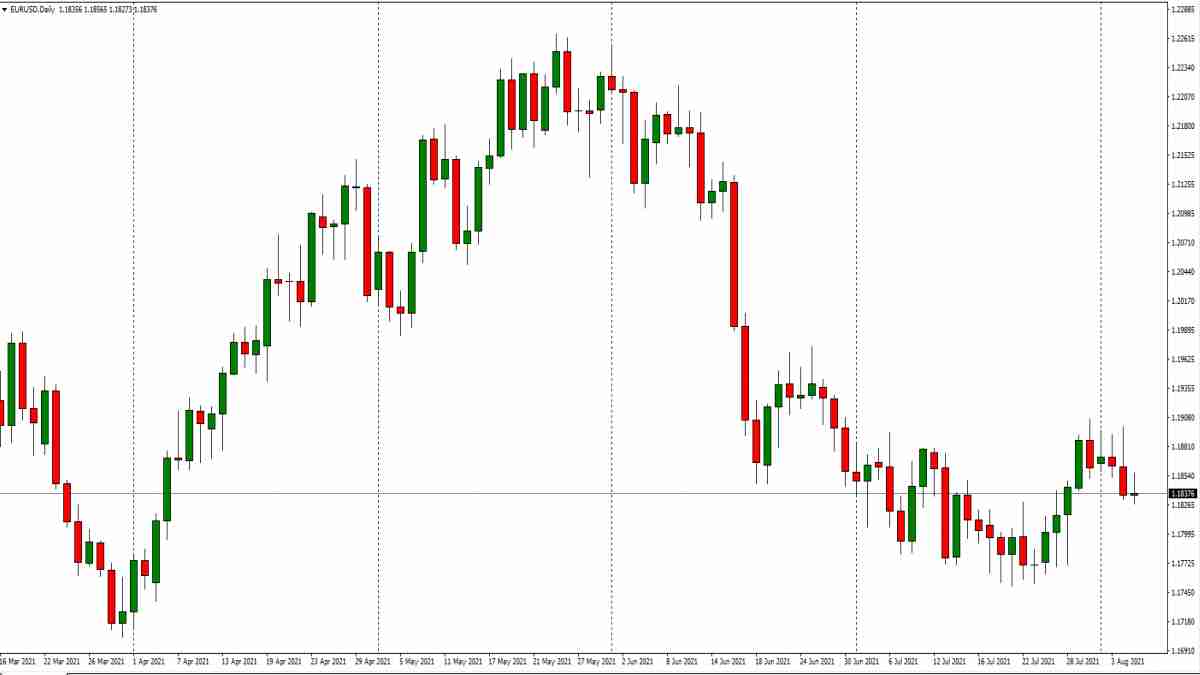
KEY TAKEAWAYS
- Fundamental analysis goal is to calculate the fair market price of a security, which the trader can compare with the current price to see if the security is undervalued or overvalued.
- Fundamental analysis in forex includes economic conditions that may affect the national currency.
- There are several major indicators to monitor when conducting fundamental analysis.
Fundamental Analysis Strategy
Fundamental analysis is a method of measuring a security's value by analysing related economic and financial factors such as a country's macroeconomics, effectiveness of the company's management etc. Fundamental analysis strategy basically through this analysis trader studies anything that can influence security's value.
Fundamental analysis is used to identify if the security is correctly valued within the broader market, it's done from a macro and micro perspective. Analysis starts first from a macro perspective, only then moved to specific company’s performance (micro).
Data can be gathered from public records. A trader, when evaluating stock, should look for revenues, earnings, future growth, return on equity, profit margins etc..
If analysis shows that the stock's value is significantly lower than the current market price, then the signal is buy. And vice versa, if fundamental analysis shows the stock's value is significantly higher than the current market price, then the signal is sell.
Fundamental analysis strategy can be categorised in two groups:
- Quantitative - information that can be shown in numbers and amounts. They are the measurable characteristics of a business, like revenue, profit, assets, and more.
- Qualitative - the nature of information, rather than its quantity. They might include the quality of a company's key executives, its brand-name recognition, patents, and proprietary technology.
Usually quantitative and qualitative methods are used in the mix, when conducting fundamental analysis.
Fundamental Analysis Forex Strategy
Traders who trade in Forex also use fundamental analysis as well. Sinse fundamental analysis is about considering the intrinsic value of an investment, its application in forex will include considering economic conditions that may affect the national currency. But if you are new to Forex trading, you can start with another article "What is Forex trading" and then continue with the fundamental strategy.
Here are some of the major fundamental factors that play a role in the movement of a currency.
- Economic Indicators - Economic indicators are reports published by the government or a private organization that detail the economic performance of a country. Trader will find here unemployment rates and numbers, housing stats, inflation etc.
- GDP - is a measure of a country's economy, and it represents the total market value of all goods and services produced in a country during a given year.
- Retail Sales - measures the total revenue of all retail stores in a given country. The retail sales report can be compared to the trading performance of a publicly traded company. What can help trader better understand the market situation.
- Industrial Production - Traders usually look to utility production, which can be extremely volatile as the utility industry, in turn, is highly dependent on weather conditions and on trade and energy demand.
- Consumer Price Index - measures change in the prices of consumer goods across over 200 different categories, when compared to a nation's exports, can be used to see if a country is making or losing money on its products and services.
There are three main indicators to look closely when applying fundamental analysis strategies.
Purchasing Managers index (PMI) - is an index of the prevailing direction of economic trends in the manufacturing and service sectors. PMI is used to provide information about current and future business conditions to company decision makers, analysts, and investors.
MI is released once a month and contains 19 primary industries' companies surveys. PMI is based on five major survey areas, that contain questions about business conditions and changes, whether it be improving, no changes, or deteriorating.
- New Orders
- Inventory Levels
- Production
- Supplier Deliveries
- Employment
PMI number spreads from 0 to 100. when PMI is above 50, it represents an expansion when compared with the previous month. When PMI reading under 50, it represents a contraction, and when it's 50 - means no change.
Formula looks like this, quite simple:
PMI = (P1 * 1) + (P2 * 0.5) + (P3 * 0)Where:
P1 = percentage of answers reporting an improvement
P2 = percentage of answers reporting no change
P3 = percentage of answers reporting a deteriorationTraders can use the PMI since it is a leading indicator of economic conditions. The direction of the trend in the PMI tends to precede changes in the trend in major estimates of economic activity and output. Paying close attention to the PMI can yield profitable foresight into developing trends in the overall economy.
Producer Price index (PPI) - is a measure of inflation based on input costs to producers. It measures price movements from the seller's point of view.
There are three areas of PPI classification:
- Industry
- Commodity
- Commodity-based final and intermediate demand
PPI measure starts with number 100 and then and when the production increases or decreases, the movements can then be compared against the starting number (100).
F.e. production of ottoman has a PPI of 108 for the month of March. The 108 indicates that it cost the ottoman manufacturing industry 8% more to produce ottoman in March than it did in February.
Employment Cost index (ECI) - is a quarterly economic series that details the growth of total employee compensation. It tracks movement in the cost of labor, measured by wages and benefits, at all levels of a company.
The index has a base weighting of 100.
So the upward trend most of the time represents a strong and growing economy; employers are passing on profits to their employees through wages and benefits. Traders use this indicator for inflationary ideas, since wages represent a big portion of the total cost for a company to produce a product or deliver a service in the marketplace.
NEW TO TRADING OR WANT TO
IMPROVE YOUR LEVEL?
Check out our Trading Academy with
professional video lessons
and articles.
Advantages and disadvantages of ECI
Advantages of ECI
- The ECI calculates the total set of employee costs to businesses, not just wages - health insurance, pensions and death-benefit plans, and bonuses.
- Rates of change are shown from the previous quarter and on a year-over-year basis.
Disadvantages of ECI
- The data is only released quarterly, and with a slight overlap, covering a mid-month period.
- ECI can be volatile when periodic bonuses, commission payments and the like are taken into account (especially at year-end - bigger bonuses).
Bottom Line on Fundamental Analysis Strategy
There are many economic indicators that can be used to evaluate forex fundamentals. It's important to take a thorough look not only at the numbers but also understand what they mean and how they affect a nation's economy. If the fundamental analysis is properly done, it can be an invaluable resource for any currency trader to make a somewhat right choice.
Sentiment Trading Strategy

KEY TAKEAWAYS
- Market sentiment reflects a market movement, based on traders' potential actions.
- Market sentiment is a third player along with fundamental and technical analysis in assessing market movement direction.
- Sentiment indicators are not exact buy and sell signals on their own, Trader has to wait for the price to confirm the reversal before acting on it.
Market Sentiment Definition
A market sentiment is an overall attitude and feeling of the investors with regards to the present price and the forecasted price of a security, index or other market instruments. Market sentiment is also called investor sentiment. It can be a positive, neutral or a negative one.
Market sentiment is important for technical analysis, since it influences the technical indicators and it is used by traders to navigate. Market sentiment is also used by opposing traders who like to trade in the opposite direction to prevailing consensus.
Investors describe market sentiment as bearish or bullish. When it's bearish - stock prices are going down. When bullish - stock prices are going up.
In these situations often time traders emotions drive the stock market and it might result in overbought or oversold cases. You can see, market sentiment driving force is feelings and emotions.
- Bullish Sentiment - in a bull market, the prices are expected to move in an upward direction. In this case greed is the moving force of the market.
- Bearish Sentiment - In a bear market, the prices are expected to move in a downward direction. In this case fear of losing money is the force.
Sentiment Trading Strategy
In Forex trading we have fundamental and technical analysis to assess currency pairs movement direction, but there is a third player that has a significant role in play, which is market sentiment. Sentiment indicator is another tool that can have an input for traders to extreme conditions and possible price reversals, and can be used in conjunction with technical and fundamental analysis. Before you continue reading about Sentiment Trading Strategy, you can strengthen your knowledge of forex trading by reading an article about "What is Forex trading and how does it work".
Market sentiment is a way of analysing Forex, stock and other markets' tendency to construct better trading strategies. These indicators show the percentage, or raw data, of how many trades or traders have taken a particular position in a currency pair.
These indicators show the percentage of how many trades or traders have taken a particular position in a currency pair. When the percentage of trades or traders in one position reaches maximum level, trader can assume that the currency pair continues to rise, and eventually, 90 of the 100 traders are long, hence there are very few traders left to keep pushing the trend up. Indication is for a price reversal.
As we mentioned earlier market sentiment is mostly created by emotions, which results in overvalued or undervalued stocks etc.. So some traders hunt those stocks and bet against them. To measure those markets traders use these indicators, not only to bet against, but to uncover the short-term trend:
- CBOE Volatility Index (VIX) - If traders feel the need to protect against risk, it's a sign of increasing volatility adding moving averages and the trader would be able to determine if it's relatively high or low.
- High-Low Index - When the index is below 30 - stock prices are trading near their lows, hence bearish market sentiment. When the index is above 70, stock prices are trading toward their highs, hence bullish market sentiment.
- Bullish Percent Index (BPI) - Measures the number of stocks with bullish patterns based on point and figure charts. When the BPI gives a reading of 80% or higher, market sentiment is extremely optimistic, with stocks likely overbought. When it measures 20% or below, market sentiment is negative and indicates an oversold market.
- Moving Averages - When the 50-day SMA crosses above the 200-day SMA - golden cross - momentum has shifted to the upside, creating bullish sentiment. And when the 50-day SMA crosses below the 200-day SMA - death cross - it suggests lower prices, generating bearish sentiment.
There are different forms and sources of Forex sentiment indicators. By using sentiment indicators, trader can learn when the reversal is likely to come, due to an extreme sentiment reading, and can also confirm a current trend.
Sentiment indicators are not buy and sell signals on their own, but they allow one to look for the price to confirm what sentiment is indicating before acting on sentiment indicator readings. Surely as any other indicator it's not 100% accurate in reading where the market is going, keep that in mind.
Trading Styles Strategies
Forex trading strategies can be developed by following popular trading styles which are day trading, carry trade, buy and hold strategy, hedging, portfolio trading, spread trading, swing trading, order trading and algorithmic trading.
Using and developing trading strategies mostly depends on understanding your strengths and weaknesses.In order to be successful in trade you should find the best way of trading that suits your personality.There is no fixed “right” way of trading; the right way for others may not work for you. Below you can read about each trading style and define your own.
Trading Styles Strategies
Forex Day Trading Strategies
KEY TAKEAWAYS
- Keep emotions at bay
- Day trading requires constant attention and stress resistance
- To succeed in day trading traders strategy should be based on deep technical analysis using charts, indicators and models to predict future price movements.
What is Day Trading Strategy
Day trading is a short term trading strategy, involves buying and selling of financial instruments within a day, to profit from small movements of price. Before you continue reading about day trading, you can improve your forex trading skills by reading our other article on "What is Forex". Day traders need to be continuously focused, since markets, such as the oil market can move suddenly in the short term. Hence these strategies are particularly effective in volatile markets.
Here are some Day trading popular techniques:
- Collection of information, because knowledge is the power, without it no trade will pull through.
- Setting aside funds, deciding how much money a trader is ready to risk. Basically setting aside money that trader is “ready to lose”.
- Having enough time, Day trading is a job- not a hobby, so it's important to devote a big chunk of the day to track markets and seize opportunities.
- Go big or go home, is not the case here - generally it’s better to start day trading with small amounts.
- Avoid illiquid stocks - they have low prices, but big break might never come. The idea of liquidity is important to have in mind when curving a trading strategy for all kinds of asset markets. Traders look for liquidity indicators in a market to enter the trade at the desired position or to suffer price volatility due to slippage. Liquidity goes alongside market capitalization and volatility in your crypto day trading strategies. In this case, liquidity not only refers to how easy it is to buy or sell a given crypto asset but also if a cryptocurrency convertible into cash or other tradable assets.
- Time of trade - Many experienced day traders begin to execute as soon as the markets open in the morning, that's when news usually breaks, which could contribute to price volatility.
- Set Stop loss - is the price at which a trader will sell a stock and take a loss on the trade (this happens when trade doesn’t go the way it was planned, in a way it’s a cutting losses approach)
- Set Take-profit point is the price at which a trader will sell a stock and take a profit on the trade.
- No emotions welcomed - when trading, generally, surrendering to greed, fear, eforia and hope is a big no-no. Clear head and pure analysis will suffice.
- Have a plan and stick to it. With fast changing situations on the market, trader can’t think on the go, so it's important to make a plan beforehand.
Best Day Trading Strategies
Day trading strategies are essential if a trader wants to benefit from frequent and small price fluctuations. An effective strategy should be based on deep technical analysis using charts, indicators and models to predict future price movements.
Below we will introduce you to the most common day trading strategies that work.
Forex Scalping Strategy
Forex Scalping Strategy
Forex Scalping Strategy is based on opening and closing multiple positions on one or more Forex pairs over the course of a day, usually in seconds or minutes during the course of a trend. But before we start, if you are new to Forex trading, it is best to start with the basics, “What is Forex trading and how does it work”.
Traders should always consider the market’s liquidity and volatility before adopting a forex scalping strategy. Using leverage is an important part as well when using a scalping strategy - it helps increase the profits (don't forget about the opposite side of the leverage).
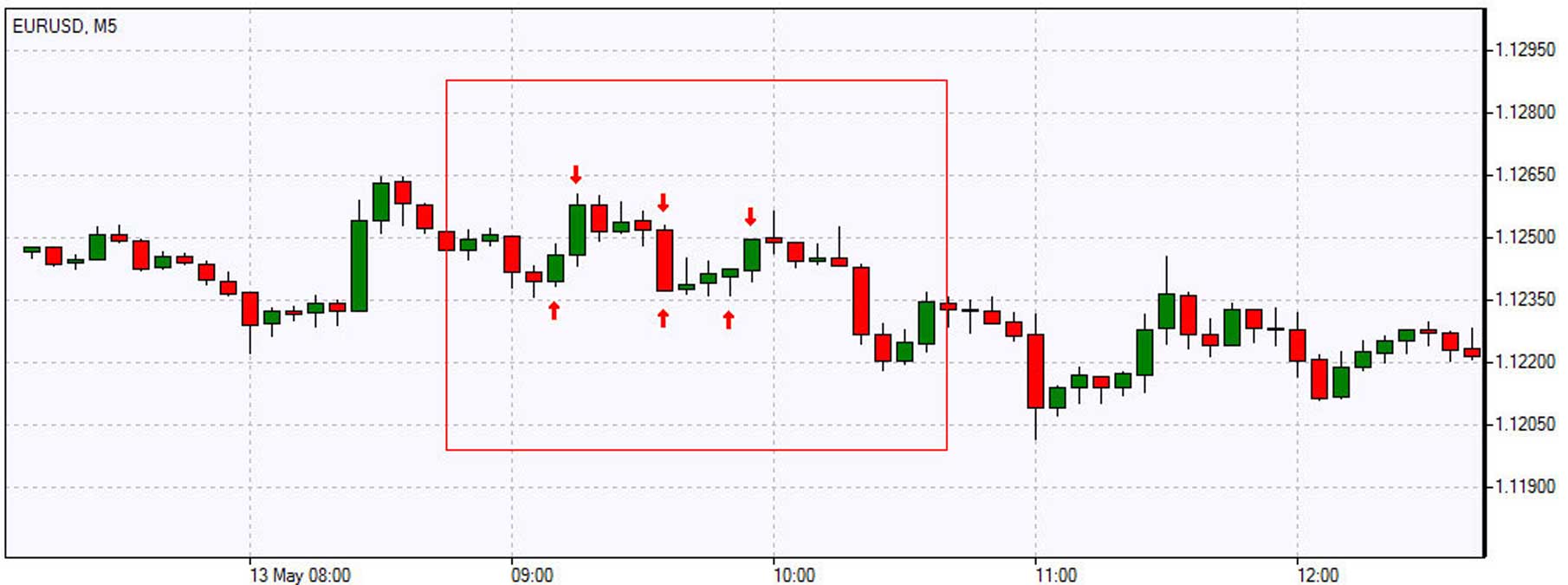
Best scalping strategies lean on use of technical indicators including Bollinger Bands, moving averages, the stochastic oscillator, parabolic SAR and RSI.
KEY TAKEAWAYS
- Forex Scalping is a short-term strategy, the goal is to make profit out of tiny price movements.
- Scalping is also considered a viable strategy for the Forex traders. However, forex scalpers usually need a larger deposit in order to be able to handle the amount of leverage they have to use to make short and small trades to work.
- The best forex scalping strategies involve leveraged trading.
- In Forex trading traders shouldn't risk more than they can afford to lose.
What is Scalping in Forex Trading
Forex Scalping is a short-term strategy, the goal is to make profit out of tiny price movements. The best forex scalping strategies involve leveraged trading. Leverage let's traders borrow capital from a broker in order to gain more exposure to the Forex market, only using a small percentage of the full asset value as a deposit. This strategy increases profits but it can also enhance losses if the market does not move in needed direction. Therefore, forex scalpers are required to keep a constant eye on the market for any changes.
How to Scalp in Forex
1. Create an account with IFC MArkets if you already have it log in to your trading account for CFDs
2. Learn about forex and how to trade it
3. Build a personalized trading plan
4. Then decide whether to go long or short and don’t forget to manage your risks
5. Open and monitor your position
But before it all, there are few things traders needs to know
- Trade The Most Liquid Pairs - EUR/USD, GBP/USD, USD/CHF, and USD/JPY are the most liquid currency pairs so they offer the tightest spreads because they tend to have the highest trading volume. Note: traders need to look for tightest spreads, because they will enter the market quite often.
- Spreads & Transaction Costs - as we mentioned before traders should be thoughtful when choosing brokers, regarding major currency pairs spreads. They have the lowest spreads, so cheapest to trade. As each trade carries transaction costs, scalping can result in more costs than profits.
- News Reports can Confuse Traders - Market volatility is widely affected by news announcements and reports like macroeconomics or GDP data, since traders usually might hurry to make a quick buck - causing chain reaction.
- Trade during the busiest times of the day - these are the most liquid times of the day, during the session overlaps - from 2:00 am to 4:00 am and from 8:00 am to 12:00 noon Eastern Time.
Risk management - Due to the small profits from scalping, traders use larger leverage than usual. Leverage can boost profits, but at the same time it can also lead to significant losses. So if the traders plan on using a higher leverage ratio, proper stop-loss money management is important.
Traders should also pay attention to their risk/reward ratio. This is because traders will often get stopped out in the majority of cases where the gap between their take profit and stop loss levels are narrow.
In Forex trading traders shouldn't risk more than they can afford to lose.
Best Scalping Strategy
As we mentioned, the best scalping strategies lean on the use of technical indicators including Bollinger Bands, Moving Averages, the Stochastic Oscillator, parabolic SAR and RSI.
Bollinger Bands is used to indicate areas of market volatility. Bollinger Bands rely on a simple moving average (SMA) with a standard deviation set above and below to show how volatile a market might be. Traders believe that wider standard deviations indicate increased volatility in and vice versa, if the bands are narrow it might mean that the market is stable.
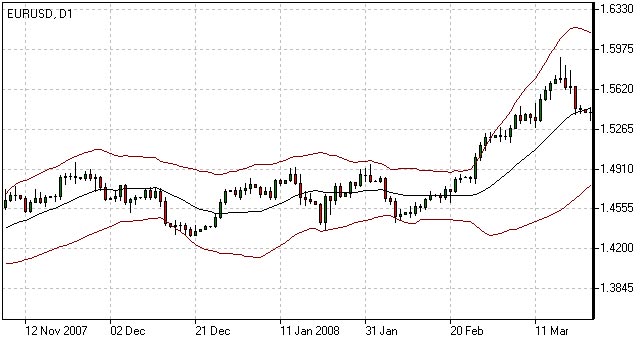
Bollinger Bands can be divided into two categories of interest to us:
- The Squeeze - When the bands move closer together, limiting the moving average, it is called a squeeze. A squeeze signals a period of low volatility and is seen as a potential sign of future heightened volatility and possible trading opportunities. Conversely, the wider the bands move, the higher the likelihood of a decrease in volatility and the higher the likelihood of exiting a trade.
- Breakouts - Any breakout above or below the bands is a major event.
Moving average (MA) - A moving average is a mathematical formula that helps to spot emerging and common trends in markets, represented as a single line showing an average. The reason for calculating the moving average of a stock is to help smooth out the price data by creating a constantly updated average price.
- Simple moving average (SMA) - s calculated by taking the arithmetic mean of a given set of values over a specified period of time.
Exponential moving average (EMA) - gives more weight to recent prices, making it more responsive to new information. Traders must first calculate (SMA) over a particular time period. Next, have to calculate the multiplier for weighting the EMA which - [2/(selected time period + 1)].
So for example, for a 30 -day moving average, the multiplier would be [2/(30+1)]= 0.0645. Then traders should use the smoothing factor combined with the previous EMA to arrive at the current value.
Stochastic oscillator - is a momentum indicator comparing a particular closing price of a security to a range of its prices over a certain period of time. Indicator is popular for generating overbought and oversold signals.
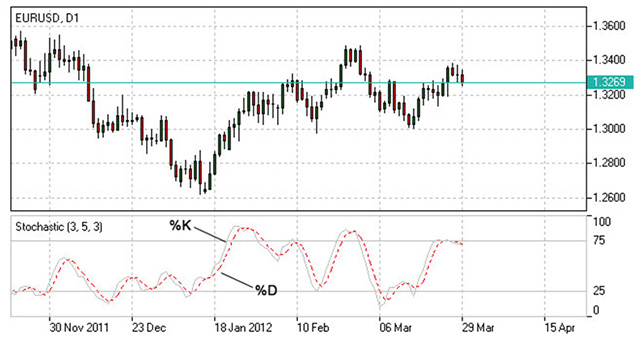
The Stochastic Oscillator chart usually consists of two lines: one represents the actual value of the oscillator for each session, and the other represents its three-day simple moving average. Since price is believed to be following momentum, the crossing of these two lines is considered a signal that a reversal may be in progress, as it indicates a large shift in momentum from day to day.
The divergence between the Stochastic Oscillator and the trending price action is also seen as an important reversal signal. For example, when a bearish trend makes a new lower low, but the oscillator makes a higher low, it could be an indicator that bearish momentum is running out and a bullish reversal is brewing.
You can see in the chart above.
Parabolic stop and reverse (SAR) - is used to determine the price direction of an asset, as well as draw attention to when the price direction is changing, also known as "stop and reversal system". On the chart appears as dots above or below the market price.
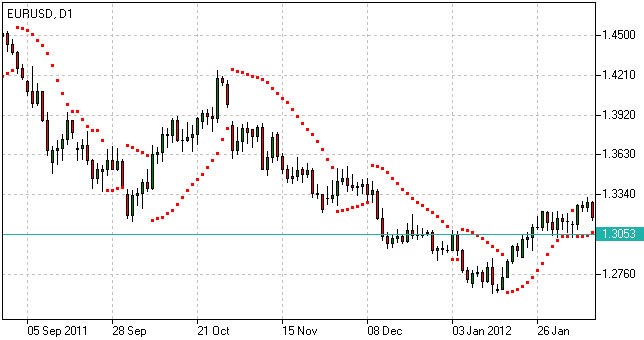
A point below the price is considered a bullish signal, and vice versa - a point above the price is used to illustrate that bearish momentum is in control and that it is likely to remain downtrend. When the dots are swapped, it means that there is a possible change in the direction of the price. For example, if the dots are above the price when they roll over below the price, this could signal a further rise in price.
As the share price rises, the dots will also rise, slowly at first, and then picking up speed and accelerating along with the trend. SAR starts to move a little faster as the trend develops, and soon the points catch up with the price.
Relative strength index (RSI) - is a momentum indicator, uses a range of between zero and 100 to assess whether the market's current direction might be about to reverse. It uses levels of support and resistance – set at 30 and 70 respectively – to identify when the market’s trend might be about to change direction.
When the RSI rises above 70, it probably shows that the market is overbought and a trader may open a short position. If the RSI falls below 30, it probably indicates that the market is oversold and a trader should open a long position.
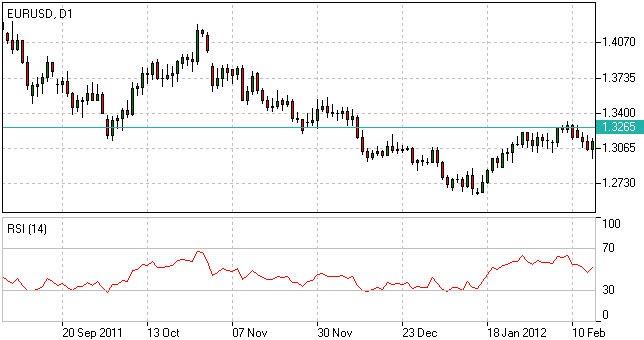
Scalpers should implement these indicators in their strategies and half of the work is done.
1 Minute Scalping Strategy
Sinse scalpers’ profits are low, they have to open multiple trades and work it to have something resembling profit. Due to the specifics of this kind of trading strategy traders have to open dozens of trades throughout the day and close them in a few seconds or minutes.
1 Minute Scalping Strategy is based on trend-following and mean-reversion which helps to bring to the minimum false signals. Though it doesn't rule out the necessity of proper risk management strategy attached to it.
Volatile market is an integral part of scalping strategy; traders are able to make money because of the price fluctuations. Some traders advise to use the New York-London session overlap; it’s when the market is the most volatile - during those few hours prices are low and liquidity is high.
For this strategy traders will need two moving averages and one oscillator.
- Instruments: any currency pair;
- Time frame: 1 minute;
- Indicators: Stochastic 5, 3, 3 and 50 EMA, 100 EMA;
- Preferred sessions: London, New York - high volatility.
Both moving averages are used to identify the current trend in the 1-minute timeframe. 50 EMA is used to calculate the average price for the past 50 minutes and the 100 EMA for the past 100 minutes. 50 EMA reacts on price movements more quickly than 100 EMA, so it’s faster, both of them give a good understanding of a trend.
- When the 50-period EMA crosses above the 100-period EMA, it means that average prices are starting to rise which is a bullish signal. Similarly, when a cross of the 50-period EMA below the 100-period EMA signals that average prices start to drop and that's a bearish signal.
- Once a short-term trend is defined traders should wait for a pullback to the moving averages. It's important because prices tend to return to their mean value after a strong up- or down-move. Waiting for pullbacks prevents traders from falling into fake signals and losses.
- The last filter Stochastic indicator will help traders to filter only high-probability trades. This indicator varies between 0 and 100 values - depending on the strength of recent price movements. When the value is above 80, it means that the recent up-move was strong and the market is overbought, hence the down-move is expected. And vice versa, when the value is below 20, the market is oversold - up-move is expected to happen.
Pros and Cons of Stock Scalping
Here below you’ll see our take on Pros and Cons of Scalping strategy and may be form your own advantages & disadvantages:
- Pros of Stock Scalping
- Can be very profitable if executed precisely and with a strict exit strategy and proper risk management
- Many opportunities to leverage small changes in the price of a stock
- No need to follow fundamentals
- Very little market risk involved
- Can be used if the market is going up or down
- Can easily be automated within the trading system, like in algo trading strategy
- Cons of Stock Scalping
- High transaction costs (if broker isn’t chosen wisely)
- Requires bigger leverage to make a profit (which can end badly)
- It is time consuming strategy and requires high levels of focus
Bottom Line on Forex Scalping Strategy
As we all know, the Forex market is large and volatile; but we have technical analysis that provides a viable strategy opportunity for trading this market. Scalping is also considered a viable strategy for the Forex traders. However, forex scalpers usually need a larger deposit in order to be able to handle the amount of leverage they have to use to make short and small trades to work.
Scalping requires focus and speed and it's vital if trades want to be successful. So if traders like the action and prefer to focus on one or two minute charts, then scalping is just what the doctor ordered. To sum up; If a trader has high tolerance to losses and a temperament to react quickly then scalping is a good match for him/her.
Fading Trading Strategy - Fading Trading
It's an opposing trading strategy, where traders trade against the prevailing trend. Fading trading strategy is risky and usually best if done by professional traders, who understands technical analytics well and are experienced in interpreting charts. Note: "Fading the market" is not for everyone.
Forex traders will often use Fading Strategy in light of major economic news releases.
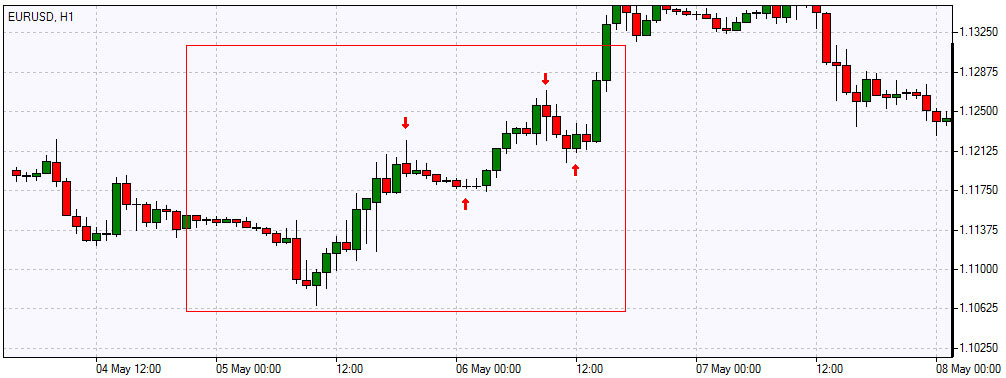
KEY TAKEAWAYS
- Traders who use a Fading trading strategy are selling when the prices are rising and buying when it is falling.
- Forex traders will often use Fading Strategy in light of major economic news releases.
- A fading strategy is most effective when there is a significant amount of volatility in the market, as there will be potentially profitable corrections.
Fading Trading Strategy
Traders who use a Fading trading strategy are selling when the prices are rising and buying when it is falling. The idea behind the fading strategy is that the market has already taken into account all the information (the direction and the trend is already in full swing), and the later stages of the trend are mainly supported by those traders who react more slowly, which will increase the likelihood of a trend reversal. But before we start, if you are new to Forex trading, you can start with the basics, “What is Forex trading”.
For example, contrarian investors might buy stocks after a company advises shareholders and the public that its earnings results will not meet analyst expectations. Contrarian investors explain their decision to buy with the market overreach.
Fading is generally a volatile strategy that will generate significant short-term profits. This does not require complex analysis, but the risk of a trend continuation is always present.
Fade Trade Meaning
Fading trading strategy means that a trader buys when the market is selling and sells when the market is buying. Even though there is an opportunity for large short-term profits with a fade strategy, a successful fade trader will not engage in this strategy blindly. There is a real risk to suffer big loss if a trend continues, but if a fade trader successfully identifies when a security is moving too far from its true value, the trader will capitalise on the reversal.
A fading strategy is most effective when there is a significant amount of volatility in the market, as there will be potentially profitable corrections. When using this strategy traders will wait for key statistics data release; earnings reports, interest rates or sales projections. Fading trading strategy can be used on stocks, though it is more suitable for Forex markets, because after reports release there are significant currency fluctuations.
Hypothetical Example
Let's say the publication of trade data by country X is better than expected. This will push the value of Country X's currency up against the US dollar and investors will begin to move capital in the hope of a rising currency X. As investors invest in Currency X, algorithmic traders will follow suit. As the price continues to rise, retail or “regular” traders will see this trend and start investing as they determine the potential profit.
At this stage, the fading trader will find that while part of this increase in the value of currency X is based on the release of positive economic data, the other part is based solely on the increase in demand and that the market is invariably correcting itself in accordance with the positive economic data. While the price rallies, the fading trader will short X currency and profit from a possible downward correction.
Bottom Line on Fading Trading Strategy
Novice traders should avoid fading trading strategies and perhaps explore alternative strategies. Using this strategy involves a lot of risk and requires the help of an expert. This includes the risk of loss as well as opportunity costs. Traders should carefully consider their financial situation and tolerance to risk before taking large fade positions. Implementation of risk management is important as well, so to sum up - proper research and risk analysis is a cornerstone for a successful fading strategy.
Daily Pivot Trading Strategy - How to Calculate Pivot Points
A pivot point trading strategy is a trader's best friend when it comes to identifying levels to develop a bias, place stops and identify potential profit targets for a trade. Pivot points are used by traders on stock and commodity exchanges. They are calculated based on the highs, lows and close prices of previous trading sessions and are used to predict support and resistance levels in the current or upcoming session. Support and resistance levels can be used by traders to determine entry and exit points for both stop losses and profit taking.
KEY TAKEAWAYS
- The pivot point is an average of the high, low and closing prices from the previous trading day.
- The success of the pivot point system depends on the trader and his ability to effectively use it in conjunction with other forms of technical analysis.
- Traders calculate pivot points to set the levels of stops, entry and profit taking.
Pivot Points Trading Strategy
As we mentioned earlier pivot points strategy could very well be traders best friend when identifying levels to develop a bias, place stops and identify potential profit targets for a trade. Before we start, if you are new to trading, it is best to start with the basics, “What is Forex trading”.
Pivot points can be used in trading to help assess upward and downward trends and determine the best points to enter or exit a trade.
Traders can use the pivot point indicator for a wide variety of financial markets such as indices, stocks, and generally Forex trading.
Here are a few Pivot Points Trading Strategies that can be used:
- Pivot Points Trend Trading Strategy - Traders can use pivot points for trend trading, using them when calculating support and resistance. The idea is that after the price has chosen the direction based on the pivot point, the trader can take advantage of corrections at significant levels. If price convincingly breaks through the first support or resistance level and then pulls back, the trader can buy or sell on the bounce off that resistance level.

- Pivot Point Bounce Strategy - The pivot point bounce is an ideal trading strategy. The idea is that if the price is above the pivot point, the market sentiment is bullish. If the price is below the pivot point, the market sentiment is bearish. The pivot point bounce takes advantage of market sentiment - buying or selling if price retraces back to the pivot point, which is a good horizontal support or resistance level.
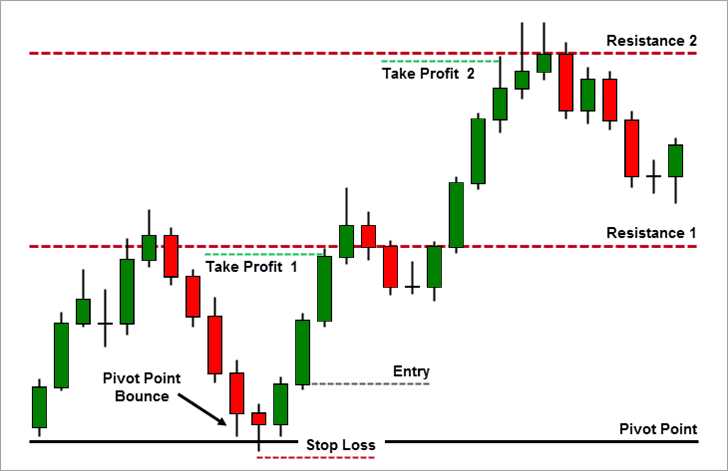
- Pivot points intraday trading - Pivot points are mostly used by day traders, on 10, 15 and hourly charts. Regardless of the timeframe used, the pivot levels stay the same as they are based on a mathematical formula for the prior day’s high, low and close. Chart time frames only show price action detail occurring around the pivot point indicator levels. For example, here is an hourly chart of the EUR/USD currency pair. The grey line in the middle represents the pivot point, with the S1, S2, and S3 below and the R1, R2, and R3 above. That can be easily seen on the chart.
- Pivot Point Reversal Strategy - Support and resistance levels calculated through pivot points can be used for reversal trades as well. If price is slowing down near the second or third support or resistance levels - it’s a good place to buy or sell respectively. The idea is that at support or resistance levels 1 and 2, the price is likely to expand. Since these levels are also usually good horizontal support and resistance levels, they are excellent areas to look for reversal trades.
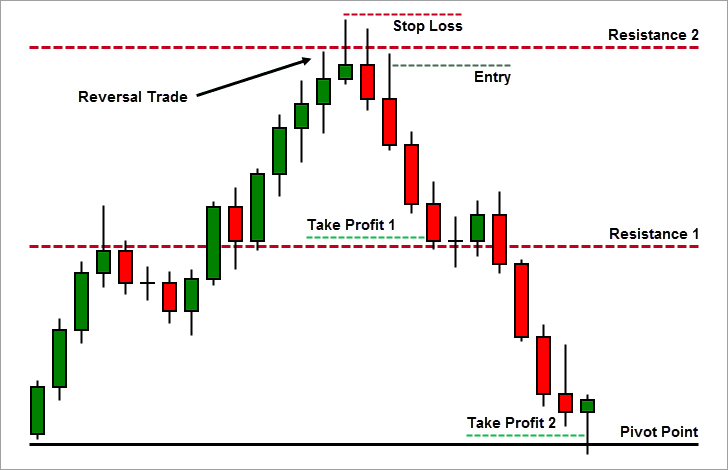
Pivot Points in Forex - The Forex market is open 24 hours a day during the week. The official forex trading day begins and ends at 5:00 pm Eastern Standard Time (EST) at the end of the US trading session. Pivot points are calculated based on the highs and lows of the entire 24-hour period, and the close at the end of the American session is used in most pivot point calculators. Sometimes levels are not always relevant for traders who only trade during the London or American session. They trade only a small portion of the day, but use an indicator based on 24-hour price movement.
Pivot points can also be applied based on four-hour or hourly highs, lows and closing prices. Traders can add pivot points to their price chart and change the indicator timeframe. This will provide more potential areas for observation over a 24-hour period. During this 24 hour period, six sets of control points are generated. This can provide more potential trades or better understanding, in particular for day forex traders.
How to Trade Using Pivot Points
The pivot point is an average of the high, low and closing prices from the previous trading day.
Pivot points can be used in two ways.
- To determine the general trend of the market. If the price of the pivot point breaks out in an upward movement, then the market is bullish. If the price falls below the pivot point, then this is a bearish move.
- Pivot price levels are used to enter and exit the market. Let's say a trader wants to place a limit order to buy 100 shares if the price breaks the resistance level. Alternatively, the trader can set a stop loss at or near the support level.
Remember only relying on one indicator in case of pivot points won’t do good for your profits.
The success of the pivot point system depends on the trader and his ability to effectively use it in conjunction with other forms of technical analysis. Other technical indicators can be; MACD to candlestick patterns, or use a moving average to help establish trend direction. The greater the number of positive indications of a trade, the greater the chances of success.
What are Pivot Points
The pivot point is an average of the intraday high and low, and the closing price from the previous trading day. It's a technical analysis indicator traders use to identify market trend over different time frames. Trading on the next day above the pivot point is indicating bullish sentiment and below the pivot point - bearish sentiment. Pivot Point is the basis indicator, but also participates in constructing Support and Resistance levels as well.
When pivot points are used in conjunction with other technical analysis tools, and can help traders improve their trades profitability.
Pivot points can be calculated on weekly bases used by swing traders, monthly bases which are used by position traders. These are used to estimate upcoming support and resistance levels.
However, pivot points are predictive tools, they don't hold 100% accuracy, therefore there is a chance of mistake. There are some limitations to pivot points; they are based on a simple calculation and there are no assurances that the price will stop, reach the levels on the chart or reverse. Some traders are well versed and know when to trust the trend and when not to. Sometimes price can move back and forth, it is advised to pivot points as any other indicators in a trading plan.
For example pivot points can be combined with Moving Average (50, 200) or Fibonacci extension level, in this case support and resistance level becomes a stronger, more reliable.
How to Calculate Pivot Points
Pivot point indicators can be added to a chart and it will automatically create levels and show it. Keep in mind that pivot points are calculated from highs, lows and closing price from the prior day.
So if the trader needs to create pivot points levels for today, he/she would need to
- High indicates - the highest price from the prior trading day,
- Low indicates - the lowest price from the prior trading day,
- Close indicates - the closing price from the prior trading day.
- Sum the high, low, and close and then divide by three.
- Mark the prize as P on the chart
- When P (price) is known, traders would need to calculate Support1 and 2 as well as resistance1 and 2.
Traders calculate pivot points to set the levels of stops, entry and profit taking. Most common way of calculating pivot point is a 5 point system.
The Formula for Pivot Points:
P = (H + L + C)/3
Pivot Point = (Previous High + Previous Low + Previous Close) / 3
R1 = (P x 2) – L
S1 = (P x 2) – H
R2 = P + (H - L) = P + (R1 - S1)
S2 = P - (H - L) = P - (R1 - S1)
where:
P - Pivot Point
L - Previous Low
H - Previous High
R1 - Resistance Level 1
S1 - Support Level 1
R2 - Resistance Level 2
S2 - Support Level 2
High indicates - the highest price from the prior trading day,
Low indicates - the lowest price from the prior trading day,
Close indicates - the closing price from the prior trading day.
Bottom Line on Pivot Trading Strategy
Pivots provide an excellent opportunity to identify areas of support and resistance, but they work best in conjunction with other types of technical analysis.
Pivot points are based on a simple calculation - an average of the high, low and closing prices from the previous trading day. There is no guarantee that the price will stop, reverse, or even reach the levels created on the chart. In other cases, the price will move back and forth through the level. Like all indicators, it should only be used as part of a complete trading plan.
The major benefit of pivot points is they work on all the financial markets and also on all the trading time frames. Traders should try not to use this indicator in the ranging conditions and also avoid the use in the highly volatile markets.
NEW TO TRADING OR WANT TO
IMPROVE YOUR LEVEL?
Check out our Trading Academy with
professional video lessons
and articles.
Momentum Trading Strategy - What is Momentum Trading
The idea of momentum investing is simple - buy low, sell high. It looks like a straightforward reaction to a market change. But it can’t be that easy. Let’s dive in and learn how it can be used and when, what are the best momentum indicators, to form an idea, when it is best used.
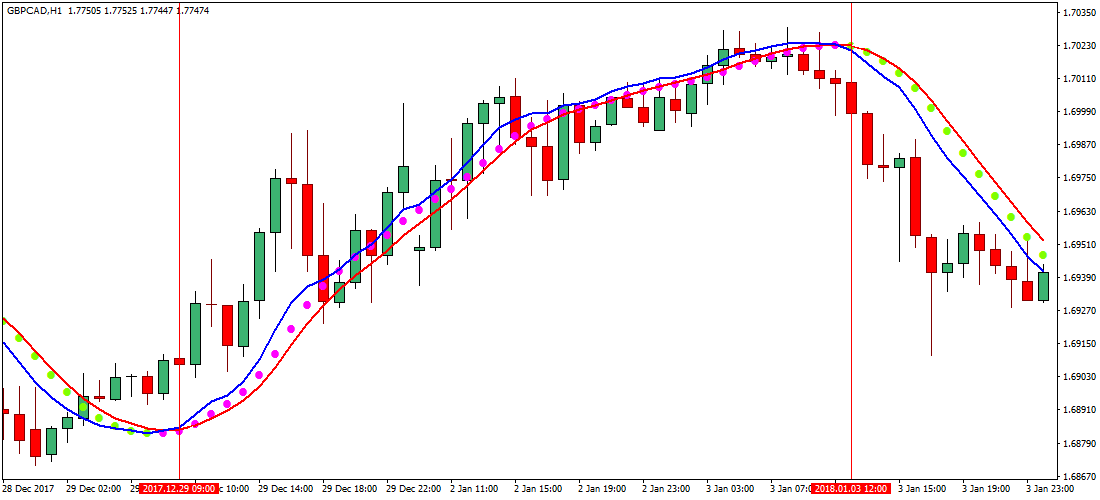
KEY TAKEAWAYS
- Momentum investing is a trading strategy in which investors buy stocks that are rallying and sell them when they have peaked and are about to drop.
- Momentum in trading is often influenced by timeframe.
- Momentum indicators are technical analysis tools that help to identify the strength or the weakness of the stock’s price.
Momentum Trading Strategy
Momentum strategy wasn’t that popular until Richard Driehaus showed the ropes: he used it to run his funds and succeeded. The idea was that with "buying high and selling higher" strategy more money could be made. He believed that selling loser stocks and buying winners is a working approach. Later on techniques he used summed up in a Momentum Trading strategy.
Momentum Trading Strategy is set to exploit market volatility; taking short -term positions on stocks that are going up and waiting until they start showing signs of falling and selling them. And along the chain goes, finding winners and buying them and selling the losers.
The momentum investor seeks to take advantage of the herd instinct of investors by leading the group and being the first to take the money and run away.
The process goes like this:
- Selecting equities
- Risks concerning the timing in opening and closing the trades
- Entry timing - getting into the trade early
- Position management with wide spreads and holding period
- Exit points require consistent charting
Worth mentioning, that momentum investing works, but not for everyone. Based on the practice of momentum investing, it can most likely lead to overall portfolio losses. When a trader buys rising stocks or sells falling stocks, it can lead to a reaction to older news than investment fund professionals.
Momentum Day Trading Strategies
Day trading requires the market to move, to be able to make money on fluctuations. Momentum trading fits into day trading perfectly from that perspective. Plus side is, there always will be a volatile market to take advantage of.
So how to find the right stock and make a move - buy low, sell high?
First of all, traders need to find a stock that is moving. Stocks that don't move aren't of interest. For that traders need to set up some kind of stocks scanning system (for example reversal trading strategies scanners).
Second, momentum stocks all have a few things in common
- Strong daily charts - above the MA and with no nearby resistance.
- High relative volume is at least 2 times higher than average - the current volume for today is compared with the average volume for that time of day.
- Fundamental reasons such as PR, profits, FDA announcement, investor activists, or other big news.
Momentum in trading is often influenced by timeframe. Though some momentum traders prefer to take positions in the long-term, one of the most appropriate strategies for trading on momentum is the short-term approach of day trading.
The aim of day trading is to enter and exit multiple positions quickly throughout the day, with the aim of making a profit from small price movements. Therefore, momentum traders look for markets and securities with a high volume, so that they can buy and sell stocks quickly without interruption.
When a range is at least $5, it is considered profitable for momentum intraday trading. Smaller price movements are better for scalping strategies, which are very common within the forex market.
What is Momentum Trading
Momentum trading is a technique where traders buy and sell financial assets after being impacted by recent price trends. Traders tend to take advantage of uptrends or downtrends in financial markets until the trend begins to fade away.
Momentum trading strategies focus on price movements, a form of technical analysis that is very popular with short-term traders. Traders calculate momentum price forecasts based on historical price trends and data, and given the volatility of financial markets, prices can move and the market can move in unexpected directions at any time.
Let's not forget that markets are also influenced by press releases and other macroeconomic events that need to be considered when building an impulse trading strategy and risk management plan.
Best Momentum Indicators
Momentum indicators are technical analysis tools that help to identify the strength or the weakness of the stock’s price. Most common momentum indicators include RSI, MACD and ADX.
- MACD - one of the most popular indicators; indicates momentum as it oscillates between moving averages as they converge, overlap, and move away from one another. An important aspect of the MACD is the histogram, which reveals the difference between the MACD line and the 9-day EMA. When the histogram is positive – over the zero-midpoint line but begins to fall towards the midline, which means weakening uptrend. On the other side, when the histogram is negative, under the zero-midpoint line but begins to climb towards it, it signals the downtrend is weakening.
- RSI - is another popular momentum indicator. Also an oscillator, the RSI acts as a metric for price changes and the speed at which they change. The indicator fluctuates back and forth between zero and 100. When RSI values are rising above 50, the signal is positive - uptrend momentum, but when the RSI hits 70 or above, it’s an indication of overbought conditions. And vice versa, RSI readings that decrease below 50 show negative, downtrend momentum. If RSI readings are below 30, though, it is an indication of possible oversold conditions.
- Average directional index (ADX) - is used to measure when a trend is gaining or losing momentum. It is calculated based on a moving average of price action over a period of time, and shown as a single line on the graph. An ADX value is 25 or over is an indication of a strong trend, and when a value is below 25 is seen as a weak trend and momentum traders will usually avoid using strategies within this range. The higher peaks on a chart show that a trend momentum is rising, whereas smaller peaks mean that momentum is entering a downtrend, which means that a trader should exit his/her position.
Momentum indicators are important tools for traders, but they are rarely used in isolation. It is more practical to use them with other technical indicators that reveal the directions of trends. Once a direction’s been determined, momentum indicators are valuable because they indicate the strength of price movement trends and when they are coming to an end.
Bottom Line on Momentum Trading Strategy
Momentum trading is not for everyone - it is risky and requires professional touch, but it has its rewards - often leads to massive profits. It takes discipline to trade in this type of style because trades must be closed at the first sign of weakness and the funds must be immediately placed into a different trade that is exhibiting strength.
Factors like commissions, rained down on momentum trading strategy and made it impractical for many traders, but low-cost brokers take on a more substantial role in the trading careers of short-term active traders. Buying high and selling higher is momentum traders' main goal, but this goal does not come without its fair share of challenges and risks.
Carry Trade Strategy
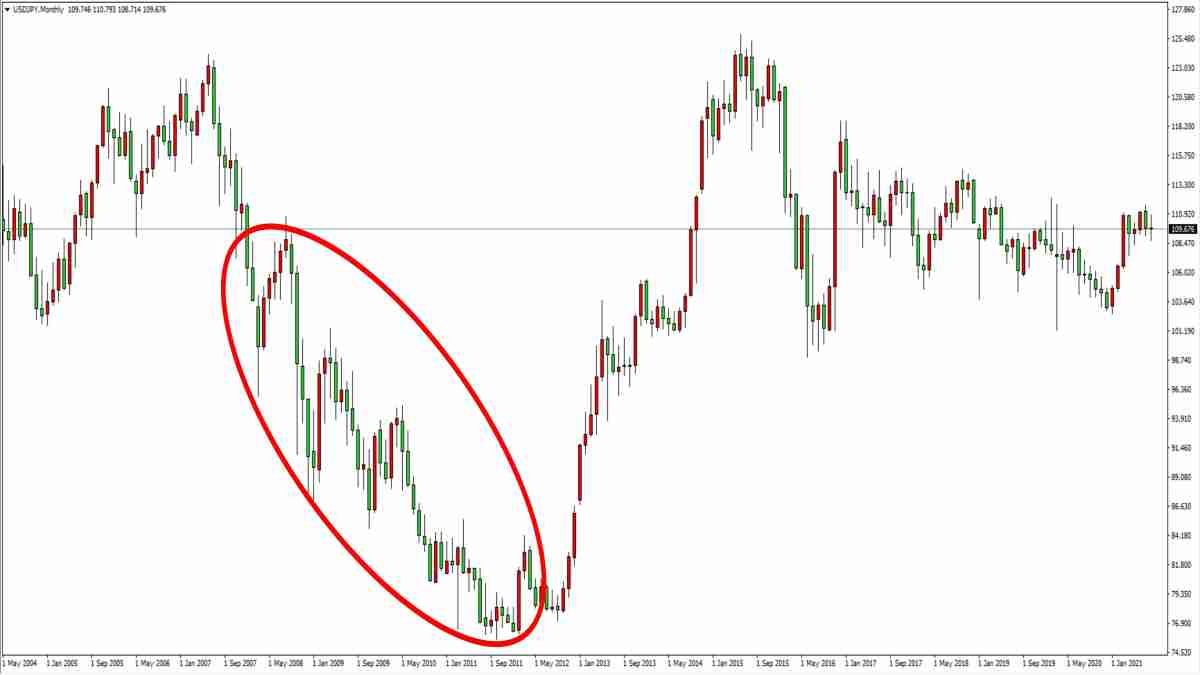
KEY TAKEAWAYS
- Carry trade strategy is very popular.
- Since carry trading is a high risk strategy, we welcome investors with a high tolerance for losses.
- When to get in a Carry Trade and when to get out.
What is Carry Trade
A Carry Trade is a trading strategy, which is borrowing at a low interest rate and investing in an asset with a higher interest rate. In other words a carry trade is most of the time based on borrowing in a currency with a low interest rate and converting the borrowed amount into another currency (if you are new to Forex trading, you can start with the basics, “What is Forex trading”). And, of course, this method can be used on stocks, commodities, real estate and bonds that are denominated in the second currency.
And as any trading strategy, Carry Trade strategy also has pros and cons:
Cons
- There is a risk of sharp decline in currencies exchange rate, which will probably kill the profit.
- Same with invested assets - they can change in price and drop the value of the income.
- Hedging is an option but not very advantageous, since money spent on insuring losses will cover the profit traders earned from difference in interest rates.
- This trading strategy can create a financial bubble.
Pros
- One of the most attractive sides of Carry trading strategy is its simplicity.
- Carry trading also lets trader use leverage, which sweetens the deal even more.
- Profitability.
Overall if a trader decides to use this strategy, it’s imperative to have the skill and be on alert if any changes are to happen.
Risk Management in Carry Trading
There is no doubt that Forex trading strategy is quite juicy but carries a fair amount of risk, to polish this strategy it's advised to use risk management. Without risk management, trader’s account can be wiped out by an unexpected turn. The best time to enter carry trades is when fundamentals and market sentiment support them. Don’t forget the proper hedging.
So when to get in a Carry Trade and when to get out?
The best time to use Carry Trading strategy is when banks are thinking, or rising interest rates - many people are starting to buy currency, hence pushing up the value of currency pair. As long as the currency's value doesn't fall traders will manage to profit.
The worst time to use Carry Trading strategy is during the period of interest rates reduction. Change in monetary policy also means a change in currency values - when rates are dropping, demand for the currency also tends to drop as well.
Conclusion
In order for the Carry Trade strategy to result in a profit, there needs to be some degree of interest rate rising or no movement.
Carry Trade Example
Suppose the investor borrows 1000 japanese Yen with 0 interest, then converts Yen in Us Dollar, and uses the sum to buy US bonds with 5,3% interest. Investor will make a profit of 5,3%, as long as the exchange rate between US dollar and Yen stays the same.
Many investors make currency carry trades, because it's simple and profitable especially when leverage is used. See more about what is leverage in Forex. For example if the trade mentioned above had a leverage of 10:1, trader would make 53% profit. But of course, the bigger potential gain the bigger is the risk, if exchange rate between US dollar and Yen change - f.e. If The US dollar falls in relation to Yen, trade will lose value. So when leverage is involved and the exchange rate changes, trader will lose ten times more value (if the trader doesn't hedge appropriately).
Bottom Line on Carry Trade Strategy
Bottom Line is that Carry Trading strategy is profitable, especially when leverage is used, quite simple and risky. To beat that trader has to implement proper risk management. Trader has to know when to get in a Carry Trade and when to get out. And the most important part, before using this type of risky strategy you have to have the skill and the experience.
Forex Hedging Strategy - Forex Hedging Techniques
Forex hedging is a method of reducing a trader's losses by opening one or more foreign exchange transactions that offset an existing position. The purpose of hedging is to reduce the risk to some extent. If you are new to Forex trading, you can read our another article about “What is Forex trading and how does it work”.
Forex market is quite liquid, as a result it's very volatile hence the risk. Every trader should know that by heart and take steps to reduce it. Hedging, as you already understood, is one of the methods used by traders to reduce the level of currency risks. Let’s dive in and learn more.
KEY TAKEAWAYS
- The purpose of hedging is to reduce the risk to some extent.
- There are two main hedging strategies in the forex market.
- Hedging strategies typically involve derivatives, such as options and futures contracts.
Hedging Meaning in Forex
Hedging in the forex market is the process of protecting a position in a currency pair from the risk of losses.
Question standing before traders is whether to hedge or not to hedge and if they decide to do so, which strategy suits them best. Keeping in mind that hedging is not free and yet it is protecting from potential losses, which might happen from time to time as a result of sharp change in the market.
Hereafter we will try to explain why traders should hedge and what options they have.
Forex Hedging Strategy
It is a form of short-term protection when a trader is concerned about news or an event triggering volatility in currency markets.
There are many hedging strategies out there but all and all we can divide them into three categories known as Forex Hedging Techniques:
Direct hedging - it's when a trader already has a position on a currency pair, and opens the opposite position on the same pairing.
For example, if a trader is long on GBP/USD, he/she will open a short position with the same trade size.
This will lead to a net profit or loss of zero, depending on the costs of opening each trade. Many traders would just simply close out the initial position and accept loss. While a direct hedge would let them make money with the second trade that would prevent this loss.
Correlation hedging - it's when a trader is looking for a correlation between currency pairs. This would involve selecting two currencies that typically have a positive correlation - move in the same direction, and then taking opposing positions on them.
For example: if traders have a long position on GBP/USD, they can hedge it with a short position on EUR/USD.
When traders use a correlation hedging strategy, it is important to remember that their risk is now spreading on multiple currencies. While positive correlation works when economies are moving in tandem, any deviation can affect the movement of each pair and correspondingly traders' hedging.
Hedging with options - To protect his / her position from market volatility, a trader can buy put or call options depending on the direction of his / her trading. Options can be viewed as short-term insurance policy and, as such, provide for the payment of an insurance premium. Since the trader pays this premium regardless of whether he / she closes or holds his / her position, options are not a break-even forex hedging strategy.
In practice, it looks like this, let's say a trader bought a put option when he / she had a long position on a currency pair, but there were concerns that influencing factors could lead to a fall in the value of the pair. A put option allows the trader to set the strike price and expiration date for the sale to be made at that strike price.
If the value fell, the trader's losses would be limited to the value of the premium payable to the option seller, plus the difference between the strike price and the price of the currency pair at the time the put was purchased.
How to Hedge Currency Risks
Currency risk can rapidly ruin profits, especially when the market is volatile. As a result, traders who put themselves in a risky situation in foreign markets: it can be traditional investments, real estate sales, commercial purchase or income generation, it is necessary to take into account the currency risk. Some may feel comfortable with the risk of exchange rate volatility and will try to take advantage of it. Others prefer to avoid such uncertainty. In any case, traders need to consider the risks associated with currency exchange so as not to jeopardize their money.
To start hedging currency risks, there are a few steps every trader should do.
- Trader has to have a clear understanding of his/her financial goals and objectives
- Traders should identify where Forex exposures are, and how that may impact their objectives
- Perform stress test and some scenario analyses
- Check in with your risk tolerance
- When choosing a hedging style and strategy, traders should consider comfortable levels of risk and financial goals
- Match the appropriate hedging products to the strategy
- Traders should track, evaluate and adjust their hedging strategy as circumstances change
If you feel ready to start hedging your currency risk, you can open an account with IFC Markets.
Bottom Line on Forex Hedging Strategy
Hedging does come with money spending, it's like insurance. Forex hedging strategy is a great way to minimize exposure to risk. It helps traders to protect against possible losses, also it can help make a profit. Traders new to the foreign exchange market should tread carefully, and should never risk more than can afford to lose, so using hedging strategies is a good start for beginners.
Novice or not, hedging is complex and requires skill, to implement it properly. Traders will need to develop confidence in speculating on market swings, and identify factors that can most likely influence the market.
NEW TO TRADING OR WANT TO
IMPROVE YOUR LEVEL?
Check out our Trading Academy with
professional video lessons
and articles.
Forex Basket Trading Strategy
Basket Trading Strategy
Diversification is a golden rule in trading, which is the basis of basket trading strategy. In other words, don't put all your eggs in one basket.
Basket trading in Forex is selling and buying different currency pairs simultaneously, they can be both correlated or uncorrelated. The goal is to exit in surplus after closing all open positions. That is, not every position needs to be won, but the total must be positive. But before we start, if you are new to trading in Forex, it is best to start with the basics, “What is Forex trading”.
KEY TAKEAWAYS
- A basket trade is a portfolio management strategy to purchase or sell a large number of securities at the same time. Strategy can be applied on futures and Forex trading as well.
- Basket trades allow investors to create a trade that is customized for them, which allows for easy distribution across many securities, and that gives them control over their investments.
- Trading baskets can be a various mix, from collections of securities and currency pairs to commodities and investing products.
What is Basket Trading
Basket trading is a type of trading that simultaneously trades a group of different securities or currency pairs. It can be used on different financial markets f.e. Forex, stock, futures, etc.
Strategy lets a trader create a list of stocks, called a basket, that he/she can save, trade, manage and track as one entity. Baskets can be used to invest in and track stocks grouped by investment style, market sector, life event, or any classification trader choose.
Note: It is important to have a good understanding of the economics of the currencies that the investor trades.Basket Trading Example
Firstly, trader should find a particular currency pair that has a clear trend - bullish or bearish. After determining the general direction of a particular currency pair based on the strengths and weaknesses of the two currencies, a basket of currencies can be selected.
For example, if a trader has established a strong USD/JPY bearish trend, it will become the base Forex pair for his/her basket. USD/JPY bearish trend means that the Japanese Yen is strengthening.
Once establishing that Yen is strengthening, instead of going short only for USDJPY pair, trader should diversify - also go short for GBP/JPY, EUR/JPY and AUD/JPY.
So if a trader planned to risk 4% only on the USD/JPY trade, now this risk can be distributed on four currency pairs - 1% on each currency pair individually. Of course, if the main trend is established wrong, losses are inevitable.
GeWorko Method
GeWorko method is a great tool for revealing correlated instruments, portfolios and trading them. This method allows traders to create a portfolio where a financial asset is quoted by another, it could be quantitative, percentage, and price ratios.
After a trader has created a portfolio, he/she can follow assets relations - figuring out if they exist (relations), for example, if relationship graph is a constant straight line it means that when one asset changes the other changes equally, or constant oblique line, it means when one asset grows the other decreases, and the trader can make a conclusion what to sell or buy.
A distinctive feature of the method is the way of expressing the value of an underlying asset, or a portfolio, through the value of a quoted asset, or a portfolio of assets based on the ratio of their prices. The GeWorko method extends the currency cross-rate model to arbitrary assets and asset portfolios.
Benefits of Basket trading
- Basket trading helps investors control their investments. Traders can add or remove individual or several securities to the basket. Tracking the overall performance of the basket of transactions also saves time monitoring individual securities and simplifies the administrative process.
- Basket trades make it easy for investors to disperse their investments across multiple securities. Investments are typically distributed using share quantity, dollar amount, or percentage weighting. Share quantity assigns an equal number of shares to each holding in the basket. Dollar and percentage allocations use a dollar amount or a percentage amount to distribute securities.
- Investors can create a basket that matches their investment goals. Baskets can contain stocks from a specific sector or stocks with a specific market cap.
NEW TO TRADING OR WANT TO
IMPROVE YOUR LEVEL?
Check out our Trading Academy with
professional video lessons
and articles.
Bottom Line
Basket trading strategy doesn’t have disadvantages, the whole purpose of it is to diversify the risks. Benefits include - personalized choice, easy distribution and control. Basket trading strategy can be applied on futures and Forex trading as well.
Losing trades is an integral part of basket trading as well, and traders should be prepared for it when creating a portfolio. When using this strategy it is important to have in portfolio assets that will offset those losses so as to come out with a profit.
Basket trading strategy has the potential for a big amount of profits, if done wisely.
Buy and Hold Strategy
KEY TAKEAWAYS
- Buying and holding strategy is one of the most popular and proven ways to invest in the stock market.
- Like any trading strategy, Buy and Hold has its pros and cons.
- Any investment that is held and sold for a period greater than a year is eligible to be taxed at a more favorable long-term rate.
What is Buy and Hold Strategy
Buy and hold is a passive investment strategy where a trader buys stocks, currency pairs or other types of securities such as ETFs and holds them for a long period regardless of short term fluctuations in the market. The idea behind buy and hold strategy centered on long term tendencies. If you are new to Forex trading, it is best to start with the basics, “What is Forex”.
Buying and holding strategy is one of the most popular and proven ways to invest in the stock market. Investors often do not need to worry about timing the market or making decisions based on subjective models and analysis. Though strategy comes with a large opportunity cost of time and money, investors must be cautious to protect themselves from market failures and know how to cut their losses and take profits, before it's too late.
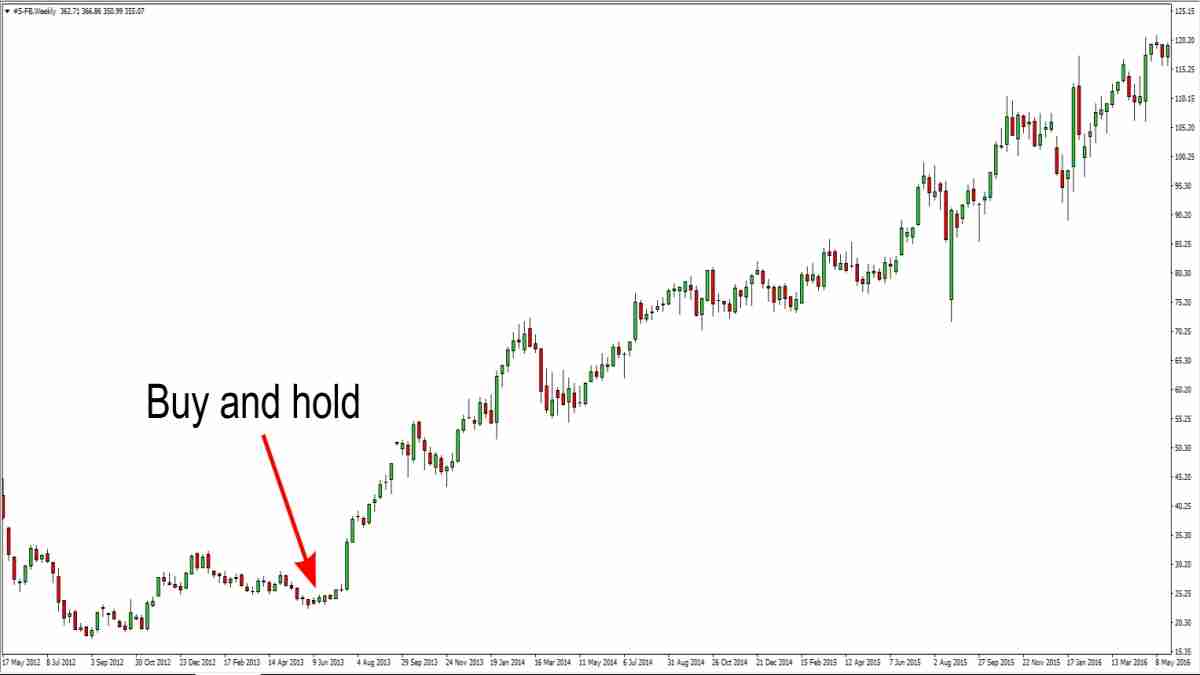
How Does the Buy and Hold Strategy Work
When investor buy stocks, a priori becomes the partial owner of the company with its privileges that include voting rights and a stake in corporate profits as the company grows. If the amount of shares bought is substantial, investor can influence and ensure his/her future profit. Shareholders vote on critical issues, such as mergers and acquisitions, and elect directors to the board.
Investors have to understand and accept that change takes time. Instead of treating stocks only as a short-term profit, like day traders, traders should invest long term through ups and downs.
Equity owners bear both the ultimate failure risk or the high reward of substantial appreciation
Pros and Cons of Buy and Hold Strategy
Pros - Buy and hold strategy has proven time and time again to generate high returns on investment. Benjamin Graham, Warren Buffett, Jack Bogle, John Templeton, Peter Lynch are titans of buy and hold strategy, their experience proved us how well this strategy can work. Of course, skill of stock-picking is the main reason for success.
It is less time and nerve consuming - Investors can sit back and look at the general characteristics of the market, the asset and the opportunities for future growth, and simply let the investment do its thing without worrying about trying to find the “perfect” entries and exits or constantly checking prices.
Friendly taxes - any investment that is held and sold for a period greater than a year is eligible to be taxed at a more favorable long-term rate, as opposed to a higher short-term rate.
Cons - When trader buy and hold stock means he/she is tied up in that asset for the long time. Hence investor has to have the self-discipline to not run after other investment opportunities during this holding period. This is difficult to practice, when bought stock is lagging.
Takes time to see positive movement - there is no specific time interval after which stock will start growing, investors have to arm themselves with patience.
Crisis - just because a stock has been held for many years, does not mean that it is infallible. If or when a crisis happens, everything might turn backwards.
Bottom Line on Buy and Hold Strategy
The buy and hold strategy is the long term investment strategy, which is perfect for investors who do not have time to keep following up their investment portfolio, on a day in day out basis. Execution of the strategy on its own is not hard, but investor has to be able to find a growing or undervalued stock. To be able realize this kind of investment strategy, investors have to be savvy in long term fundamental analysis, on micro and macro levels.
Spread / Pair Trading Strategy
KEY TAKEAWAYS
- The stocks in a pairs trade must have a high positive correlation, which is the driving force behind the Pair Trading Strategy.
- Calendar Spread Options goal is to profit from a neutral or directional stock price move to the strike price of the calendar spread with limited risk if the market goes in the other direction.
- Calendar spreads allow traders to construct a trade that minimizes the effects of time.
- The calendar spread is most profitable when the underlying does not make any big moves in either direction till the expiration of the next month of the option.
Pair Trading Strategy
Pair trading is a trading strategy that involves matching a long position with a short position in two stocks with high correlation. Strategy is based on the historical correlation of two stocks. The stocks in a pairs trade must have a high positive correlation, which is the driving force behind the strategy’s profits.
The pair trading strategy is best used when a trader detects a correlation divergence. Based on the historical belief that two securities will maintain a certain correlation, should be used when correlation falters. Profits are possible when underperforming stock regains value and the price of a higher quality security falls. The net profit is the total gained from the two positions.
Pairs trading strategy works with stocks as well as with currencies, commodities and even options.
What is Spread Trading
Spread Trading is the act of purchasing one security and selling another related security as a unit. Spread trades are usually used with options or futures contracts, to get an overall net trade with a positive value called the spread. Spread Trading is done in pairs which eliminates execution risk.
Benefits of Spread Trading
- Offers a lower risk opportunity.
- When choosing trades carefully and monitoring them continually, the probability of collecting the full premium at expiration is high.
- Trades usually last 6 – 21 days, which means, capital is continually working for a trader.
- Spread trading provides opportunities for steady income.
- It’s a perfect strategy to use when the market is volatile.
Disadvantage of Spread Trading
- Lower profits.
Types of Spread Trades
There are a few types of spread trades:
- Intracommodity (Calendar) spreads - is a spread trade involving the simultaneous purchase of futures or options expiring on a particular date and the sale of the same instrument expiring on another date. These individual purchases, known as the legs* of the spread, vary only in expiration date; they are based on the same underlying market and strike price.
- Intercommodity spreads - These spreads are formed from two distinct but related commodities, reflecting the economic relationship between them.
- Option spreads - are formed with different option contracts on the same underlying stock or commodity.
- IRS (Interest rate swap) spreads - are formed with legs* in different currencies but the same or similar maturities.
* Each transaction at spread trading is called a leg.
What is Calendar Spread Options
The calendar spread is an options strategy that consists of buying and selling two options of the same type and strike price, but different expiration cycles.
There are Vertical and Diagonal spreads.
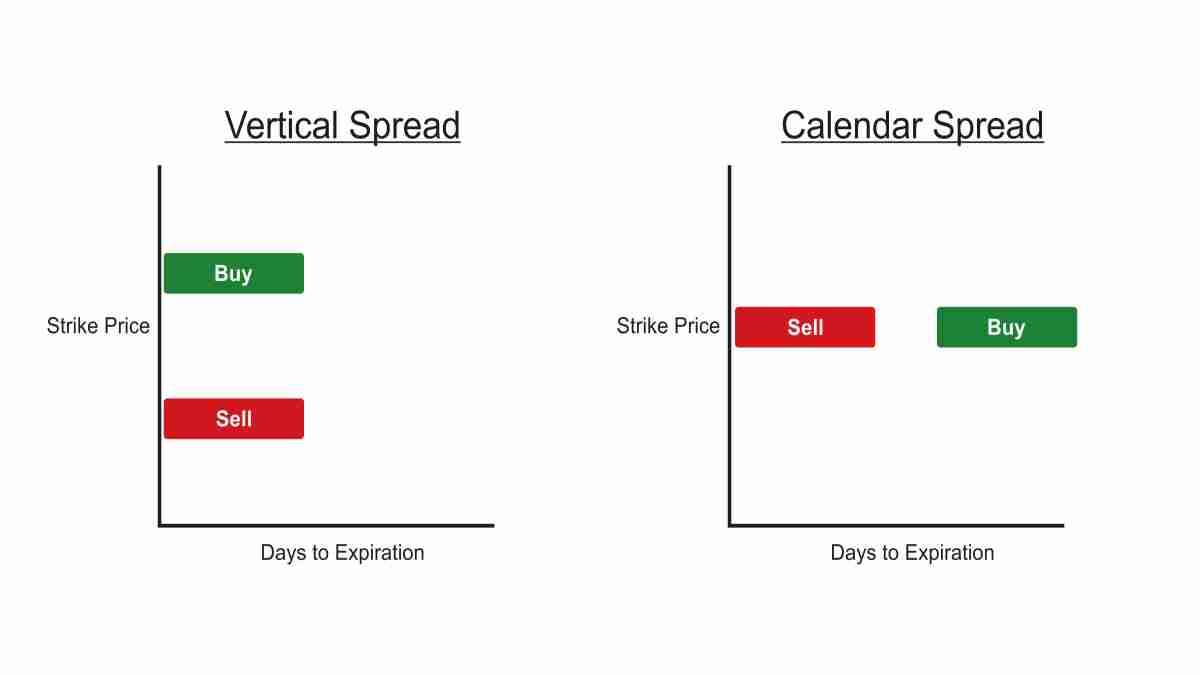
Calendar spread is an option or futures strategy that occurs by simultaneously opening a long and a short position on the same underlying asset, but with different delivery dates. In a typical calendar spread, trader would buy a longer-term contract and go short a nearer-term option with the same strike price. If two different strike prices are used for each month, it is known as a diagonal spread.
The typical calendar spread trade involves the sale of an option (either a call or put) with a near-term expiration date and the simultaneous purchase of an option (call or put) with a longer-term expiration. Both options are of the same type and typically use the same strike price. And there is a reverse calendar spread - where a trader takes the opposite position; buying a short-term option and selling a longer-term option on the same underlying security.
To sum up in technical terms, the calendar spread provides the opportunity to trade horizontal volatility skew - different levels of volatility at two points in time - and take advantage of the accelerating rate of time decay, while also limiting exposure to the sensitivity of an option's price to the underlying asset. The horizontal skew is the difference of implied volatility levels between various expiration dates.
Calendar Spread Options Example
Hypothetically, AmerisourceBergen Corp. ABC stock is trading at $73.05 in mid-April, trader can enter into the following calendar spread:
Sell the Jun 73 call for $0.87 ($87 for one contract)
Buy the July 73 call for $1.02 ($102 for one contract)
The net cost (debit) of the spread is thus (1.02 - 0.87) $0.15 (or $15 for one spread).
This calendar spread will pay off the most if ABC shares remain relatively flat until the Jun options expire, allowing the trader to collect the premium for the option that was sold. Then, if the stock moves upward between then and July expiry, the second leg will profit.
The ideal market move for profit would be for the price to become more volatile in the near term, but to generally rise, closing just below 85 as of the Jun expiration. This allows the Jun option contract to expire worthless and still allow the trader to profit from upward moves up until the July expiration.
PRACTICE MAKES PERFECT
The Bottom Line on Pair Trading Strategy
The market is full of ups and downs that can kick unprepared weak players. Fortunately, using market-neutral strategies like the pairs trade, investors and traders can find profits in all market conditions. The appealing part of Pairs trade strategy is in its simplicity.
Swing Trading Strategy
KEY TAKEAWAYS
- Swing trading involves taking trades that can last from a couple of days to several months in order to profit from the expected price movement
- Though swing trading is more of a long term strategy, it can be used on the daily charts as well.
- Swing trading is the process of determining where the stock price can move next, entering a position and then making a profit if that move occurs.
What is Swing Trading Strategy
Swing Trading is a long term trading strategy, when trades are kept open from a few days to, sometimes, several weeks. Swing trading strategy’s essence is taking advantage of market big fluctuations "swings". Fundamental analysis plays an important role on longer timeframes. But before we start, if you are new to Forex trading, you can start with the basics, “What is Forex”.
Strong directional moves are often triggered by important or unexpected market news, such as corporate income statements or central bank meetings, which means swing traders need to be aware of market fundamentals. There are ways to develop a reliable trading plan. Here are the most common swing trading techniques we’d like to share with you.
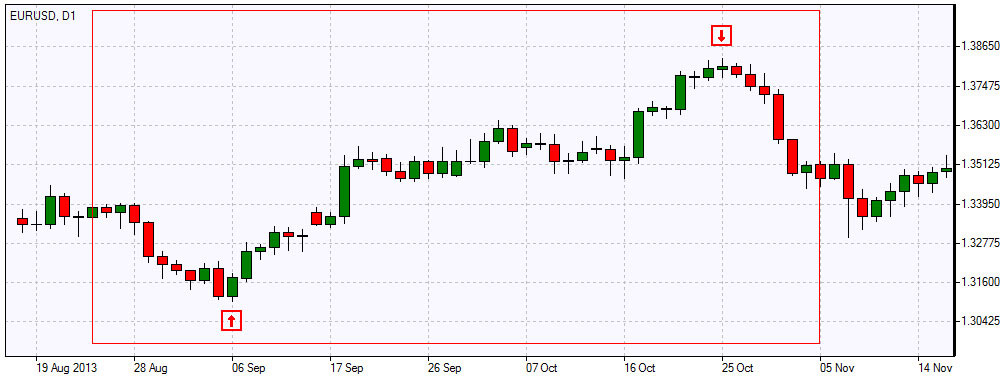
Though swing trading is more of a long term strategy, it can be used on the daily charts as well.
Positive sides
- Traders using this technique need less time to trade than day trading.
- Simplifies the trading process, since traders can rely only on technical analysis.
Negative sides
- Because traders use swing trading on the daily charts they may often miss the longer-term trends in favor of short-term market moves.
- Sharp market reversals can lead to significant losses.
What is Swing Trading
Swing trading involves taking trades that can last from a couple of days to several months in order to profit from the expected price movement. The goal of swing trading is to find some of the potential price movement. Some traders may be looking for volatile stocks with obvious big moves, while others may prefer quieter stocks.
In both cases, swing trading is the process of determining where the stock price can move next, entering a position and then making a profit if that move occurs.
Swing Trading Strategies That Work
There are ways to develop a reliable trading plan. Here are the most common technical indicators that can be used to help develop swing trading strategies that will work.
Swing Trading Tactics
- Moving average crossovers - When the shorter-term MA crosses above the longer-term MA, it's a buy signal, as it indicates that the trend is shifting up. This is known as a "golden cross."
- Cup-and-handle patterns - A cup and handle is a technical chart pattern that resembles a cup and handle where the cup is in the shape of a "u" and the handle has a slight downward drift. A cup and handle is considered a bullish signal extending an uptrend, and is used to spot opportunities to go long.
- Head and shoulders patterns - A head and shoulders pattern is a technical indicator with a chart pattern described by three peaks, the outside two are close in height and the middle is highest. A head and shoulders pattern describes a specific chart formation that predicts a bullish-to-bearish trend reversal.
- Flags - Flags are areas of tight consolidation in price action showing a counter-trend move that follows directly after a sharp directional movement in price. The pattern typically consists of between five and twenty price bars. Flag patterns can be either upward trending (bullish flag) or downward trending (bearish flag).
- Triangles - A triangle is a chart pattern, depicted by drawing trendlines along a converging price range, that connotes a pause in the prevailing trend. Technical analysts categorize triangles as continuation patterns.
The Bottom Line on Swing Trading Strategy
Swing trading is actually one of the best trading styles since it offers significant profit potential for traders. Swing traders receive feedback on their trades after a couple of days which is a good point to keep them on toes and motivated.
Swing trading in a way is in the middle of between day trading to trend trading - trend trading offers greater profit potential if a trader is able to catch a major market trend of weeks or months and stay steady (which is hard) and day trading - trading dozens of stocks per day, is exhausting. Swing trading is kind of a smart mixture of two.
Trading Order Types Strategy - Forex Order Types
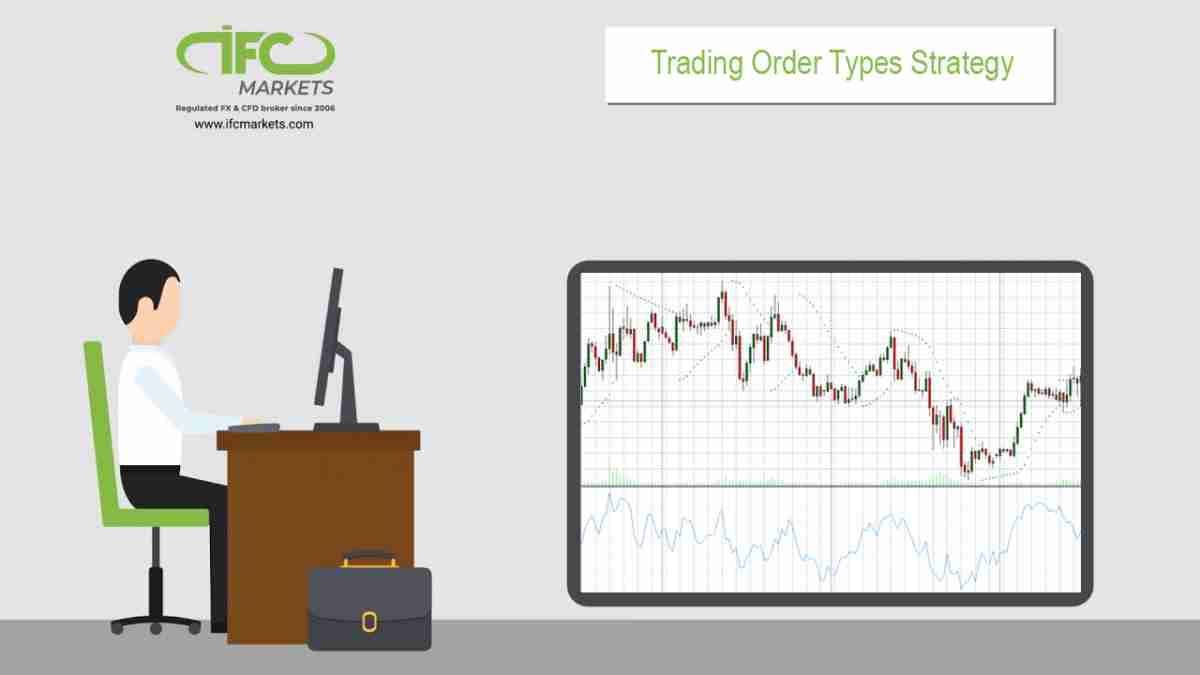
Before any trader starts to buy or sell stocks it's important to implement a trading order strategy. And before that traders have to have an understanding of what type of order in which cases to use.
KEY TAKEAWAYS
- Depending on trading style, different types of orders can be used to trade stocks more effectively.
- Orders help traders complement their investing style.
- Market orders executed the most quickly, but they do not guarantee particular execution prices.
Trading Order Types Strategy
A stock order is a set of instructions traders send to a brokerage to buy or sell securities. Below we will introduce to you order types, so that you would be armed and ready to use it in your investing strategy.
Let’s go
Forex Order Types
1. Market order - most simple type of trade; it is an order to buy or sell immediately at the current price. Important thing to remember - the last traded price is not necessarily the price at which the market order will be executed. In volatile markets, the price at which traders execute the trade can differ from the last traded price. The price will remain the same only when the bid/ask price is exactly at the last traded price.
Note: market orders guarantee the order's immediate execution, but do not guarantee a price
2. Limit order - sometimes referred to as a pending order, is a type of order that allows trader to buy or sell a security at a certain price in the future . In a limit order, the trader can set the price, unlike market order, where the trader doesn't have any control over price.
Limit order can be used during high volatility; it helps to control the price at which we buy or sell a security. Limit order is convenient when traders are not actively following the price movement of a stock and want to buy or sell at a predetermined price.
There are 4 types of limit orders:
- Buy Limit - an order to buy a security at a specified price or below. Limit orders must be placed on the correct side of the market to ensure that they get the job done when the price rises. For a limit buy order, this means placing an order at or below the current market price.
- Sell Limit - an order to sell a security at or above a specified price. To ensure an improved price, the order must be placed at or above the current market ask.
- Buy Stop - an order to buy a security at a price above the current market bid. A stop order to buy becomes active only after a specified price level has been reached; known as the stop level. Buy stop orders are placed above the market and sell stop orders placed below the market. Once a stop level has been reached, the order will be immediately converted into a market or limit order.
- Sell Stop - an order to sell a security at a price below the current market ask. Like the buy stop, a stop order to sell becomes active only after a specified price level has been reached.
3. Stop-loss Order - A stop-Loss order is one of the most important types of orders where - trader can limit his losses by exiting a trade if a specific price is reached. When placing a stop-loss order, traders can protect themselves from incurring high losses if the price goes against them.
When a trader places a buy order, he is expecting the price to go up, so that he can earn a profit. But at the same time the price might go down, so to avoid losses the trader places a stop loss order at a price below the buy price.
Example
A trader places a buy order:
Share price = Rs. 200
Stop loss at Rs. 198
Trader expects the share price to go higher, to earn a profit. In case the price falls below Rs. 200, say it falls to Rs. 195.
The trader will book a loss of Rs. 2 per share (200 – 198) and exit the trade.
If he had not put a stop-loss, the loss would have been Rs (200-195) = Rs 5 per share, which is greater than the above scenario.
Similarly, when a trader places a sell order, he expects the price to fall, so that he can earn a profit.
But it may happen that instead of the price going down, the price goes up. So to avoid high losses when prices go down, trader can put a stop-loss at a price higher than the selling price.
If a trader has placed a buy order at Rs. 200, he can place a stop-loss price at Rs. 195.
In case the price goes down, he will book a loss of Rs. 5 per share and exit the trade.
4. Stop-Limit Order - A stop-limit order contains two prices: the stop price, which converts the order into a sell order, and the limit price. Instead of becoming a market sell order, a sell order becomes a limit order that will only execute at the limit price or better. This can mitigate a potential problem with stop loss orders, which can be triggered during a sudden crash when prices fall but subsequently recover.
5. All or None - This type of order is especially important for those buying cheap stocks. An all-or-nothing ordering ensures that the trader will either receive the entire amount of the requested quantity of stock or not receive it at all. This is problematic when the stock is very illiquid or there is a limit on the order.
For example, if you place an order to buy 2,000 ABC shares, but only 1,000 are sold, the all-or-nothing limit means that the trader's order will not be executed until at least 2,000 shares are available at the preferred price. If the trader does not place an all-or-nothing limit, the order for 2,000 shares will be partially filled for 1,000 shares.
6. Immediate or Cancel - any order amount that could be executed in the market in a very short period of time, most often in a few seconds or less, would be filled, then the rest of the order would be canceled. If no shares are traded during this "immediate" interval, the order is completely canceled.
7. Fill or Kill - combination of AON order with IOC specification, the idea behind is - the entire order size to be traded in a very short period of time (a few seconds), if conditions aren’t met order is canceled.
8. Take Profit - sometimes traders call this order profit target. Take profit is always connected to an open position of a pending order and intended to close out the trade at a profit as soon as it has reached a certain level.
9. Day - when trader doesn't specify a time frame of expiry through instructions, order will be set as a day order, in other words at the end of a trading day the order will expire and the trader will have to re-enter the transaction the next day.
10. Good 'Til Canceled - order will stay active until trader decides to cancel it, surely brokerage companies put a time limit on this type of order usually maximum time of order is about 90 days.
11. OCO - a pair of conditional orders specifying that if one order executes, then the other order is automatically canceled. When either the stop or limit price is reached and the order executed, the other order automatically gets canceled. Usually this order is used to soften the risk and to enter the market.
For example, if the stock price is between $ 50 and $ 52, a trader can place an OCO order with a buy stop just above $ 52 and a sell stop just below $ 50. As soon as the price breaks above resistance or below support, the trade is executed and the corresponding stop order is canceled.
And vice versa, if a trader wants to use a correction strategy that involves buying at support and selling at resistance, he can place an OCO order with a buy limit order at $ 50 and a sell limit order at $ 52.
Buy Limit vs. Sell Stop Order
Experienced traders typically use buy and sell orders for their trades, but it doesn’t secure them from slippage. Slippage refers to the difference between the expected price of a trade and the price at which the trade is executed. Brokerage companies offer more advanced types of orders that allow specify buy and sell prices in the market, which can help prevent a trader from losing money.
In other words advanced orders eliminate slippage and ensure that trades are executed at the right price if or when the market price is reached. Above we showed different types of orders used in trading, let us show now the key differences between most used: orders buy limit and sell stop order.
- A limit order sets the specified price for the order and executes the trade at that price.
- A buy limit order will be executed at or below the limit price.
- A limit sell order will be executed at the limit price or higher.
- A limit order allows traders to specify a price.
- A stop order includes a specific parameter for triggering a trade. Once the stock price hits the stop price, it will be executed at the next available market price.
- A stop order is usually assigned for margin trading or hedging purposes as it usually has restrictions on how to enter the price.
- Therefore, a buy stop should usually include a price above the current market price, and a sell stop should include a price below the current market price.
- A buy stop order will be executed at the next available market price after the buy stop price parameter is reached.
- A sell stop will be executed at the next available market price after the sell stop is reached.
- Buy stops are usually used to close a short position in a stock, while sell stops are usually used for stop losses.
Bottom Line on Order Types Strategy
Traders have to know the difference between limit and market order. Depending on the situation one or another will be a more suitable approach. Depending on the investment approach, order type can be influenced, as well.
A long-term investor is more likely to choose a market order because the decision is based on fundamental principles that might last for months and years, so the current market price is not an issue.
The trader, however, tends to act in accordance with the short-term trend on the charts and is therefore much more aware of the market price paid; a limit order to buy in with a stop-loss order to sell is usually the bare minimum for setting up a trade.
When traders know what each order does and how each one might affect trading, they can identify which order suits their investment needs, that saves time, more importantly reduces risks and saves money.
Algorithmic Trading Strategies

Method of order execution using pre-programmed automatic trading instructions, taking into account variables such as time, price and volume, is known as algorithmic trading.
In the trading world automated trading is also called algo-trading, automated trading, or even black-box trading. It is a computer program that follows a set of instructions for placing a trade. This type of trading can be profitable at a speed and frequency beyond the reach of a human trader.
Algo-traders can make thousands of trades per second, so if an algorithm is set right, it might become potentially a very powerful tool.
A study in 2019 showed that around 92% of trading in the Forex market was performed by trading algorithms rather than humans.
Let’s see what it is all about.
KEY TAKEAWAYS
- Method of order execution using pre-programmed automatic trading instructions, taking into account variables such as time, price and volume, is known as automated trading.
- With algo trading, traders can run the algorithms based on past data to see if it would've worked in the past. It lets the user remove any flaws of a trading system before trying it out live.
- Trend-following Strategies - one of the most common automated trading strategies to follow trends in moving averages, channel breakouts, price level movements, and related technical indicators.
- Automated trading has gained in importance in recent years in the financial industry, and this trend is likely to proceed.
Automated Trading Strategies
A sophisticated algorithm should ideally take into account many factors and analysis, such as movements of price, market volatility, chart analysis and other nonetheless important factors. There are many strategies that are widely used for trading and they vary greatly in many complex ways.
Strategies mentioned below are considered Best Automated Trading Strategies.
- Index Fund Rebalancing - Rebalancing is a process where the underlying assets of funds are readjusted according to current market conditions. For example, a pension fund is supposed to be a combination of 50% stocks and 50% bonds. In a few years the value of stocks increases, and now compromises 75% of the portfolio. During rebalancing, some of the stocks are sold, in order to bring back the portfolio to the original 50-50 allocation, and the trader profits. These rebalancing transactions are now automatized by algorithms.
- High frequency arbitrage - buying a dual-listed stock at a lower price in one market and simultaneously selling it at a higher price in another market offers the price differential as risk-free profit or arbitrage. Same can be done for stocks vs. futures instruments. Implementing an algorithm to identify such price differentials and placing the orders efficiently allows profitable opportunities.
- Trading Range (Mean Reversion) - strategy is based on the concept that the high and low prices of an asset are a temporary phenomenon and they will revert to their mean value (average value) periodically. Identifying and defining a price range and implementing an algorithm based on it allows trades to be placed automatically when the price of an asset breaks in and out of its defined range.
- Trend-following Strategies - one of the most common automated trading strategies to follow trends in moving averages, channel breakouts, price level movements, and related technical indicators. These are the easiest and simplest strategies to implement through automated trading because these strategies do not involve making any predictions or price forecasts. Trading is initiated as soon as the desired trends appear, which are easy and simple to implement using algorithms, without going into the complexity of predictive analysis. Using 50- and 200-day moving averages is a popular trend following strategy.
- Mathematical Model-based Strategies - Proven mathematical models, allow trading on a combination of options and the underlying security. Delta neutral (mathematical model) is a portfolio strategy consisting of multiple positions with offsetting positive and negative deltas—a ratio comparing the change in the price of an asset, usually a marketable security, to the corresponding change in the price of its derivative—so that the overall delta of the assets in question totals zero.
- Time Weighted Average Price (TWAP) - the aim of this strategy is to execute the order close to the average price between the start and end times thereby minimizing market impact. Time-weighted average price strategy breaks up a large order and releases smaller chunks of the order to the market using evenly divided time slots between a start and end time.
- Volume-weighted Average Price (VWAP) - The idea behind this strategy is somewhat the same as the Time Weighted Average Price (TWAP)- volume-weighted average price strategy breaks up a large order and releases smaller chunks of the order to the market using stock-specific historical volume profiles. The goal is to execute the order close to the volume-weighted average price (VWAP).
- Percentage of Volume (POV) - until a trade order is fully executed, this algorithm continues to send partial orders according to a certain participation rate and according to the trading volume in the markets. This strategy submits orders, based on the user-defined percentage and increases or decreases this participation rate when the stock price reaches levels the trader has set.
- Implementation Shortfall - This strategy's goal is to minimize the execution cost of an order by trading off the real-time market, which helps saving on the cost of the order and benefiting from the opportunity cost of delayed execution. The strategy will increase the targeted participation rate when the stock price moves favorably and decrease it when the stock price moves adversely.
Benefits of Automated Trading
The main reasons automated trading has become so popular are because of its advantages in speed, accuracy and lower cost compared to manual trading.
- Speed is one of the advantages of algo-trading. Trades are being executed automatically and with great speed, since they are planted and written beforehand.
- Quantity of indicators - trading with algorithms has the advantage of scanning and executing on multiple indicators at a speed that no human could do - trades can be analyzed and executed faster, hence more opportunities are available at better prices.
- Accuracy - computer automatically executing trades, which does rule out human error. For instance buying the wrong currency pair, or for the wrong amount.
- Emotions are not going to stand in the way of rational decisions, thankfully everything is already automated and algorithm is running its course.
- Ability to backtest - With algo trading, traders can run the algorithms based on past data to see if it would've worked in the past. It lets the user remove any flaws of a trading system before trying it out live.
- Reduced transaction costs - with algo-trading traders don’t have to spend so much time analysing and monitoring markets.
IFC Markets has developed its own NetTradeX trading platform that also provides automated trading by NetTradeX Advisors. We welcome you to try.
Trading Algorithms Examples
For example, a trader wants to find an arbitrage opportunity, and finds stock that is traded on two different exchanges with one - hour gap between them plus stock that is traded in different currencies. Here is a valid opportunity of arbitrage.
Let’s say f.e. Alexion Pharmaceuticals Inc.Stock , ALXN is listed in London and New York stock exchanges. Trader then will start looking for arbitrage opportunities (based on difference in buy, sell prices in these two exchange platforms) and start forming the algorithm to exploit it.
What does trader needs to make it work when using algo-trading
- A computer program that can read current market prices.
- Price feeds from both exchanges.
- A forex (foreign exchange) rate feed for GBP-USD.
- The ability to place an order, which can route the order to the correct exchange.
- Backtesting capability on historical price feeds.
In practice algorithmic trading is not that simple to maintain and execute. Since alo-trading is available to all: if one trader uses it others might too, hence prices fluctuate in microseconds. If a buy trade is executed but the sell trade does not because the sell prices change by the time the order hits the market, the trader will be left with an open position making the arbitrage strategy worthless.
There are some risks concerning algo - trading for example connectivity failure, or time lag between trade orders and executions and most important flawed algorithm.
Bottom Line on Automated Trading Strategies
Automated trading has gained in importance in recent years in the financial industry, and this trend is likely to proceed. Electronic trading platforms have been created in the recent past attracted primarily algorithmic traders due to their tariffs and quick response.
A significant percentage of the daily stock turnover is due to ECN. The implementation of automated trading systems requires some technical effort but also great knowledge in market microstructure (since humans can react on the market using his/her knowledge and feeling, but machine can't traders should implement microstructure of the market in the algorithm) but it’s worth the effort.


